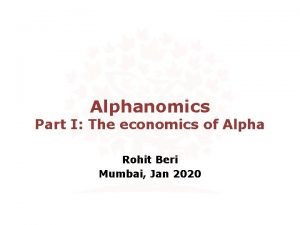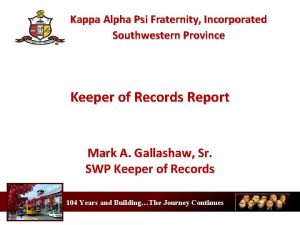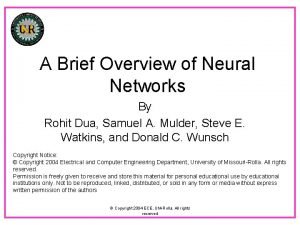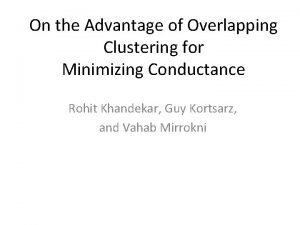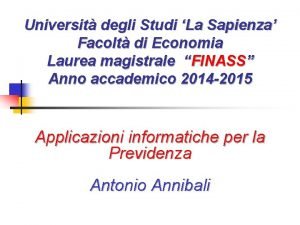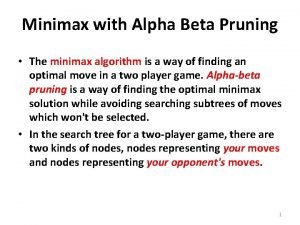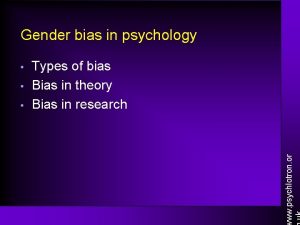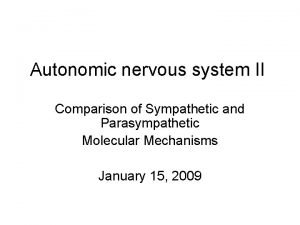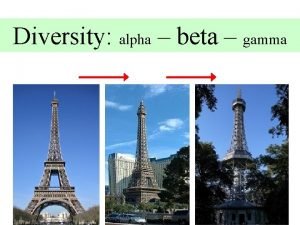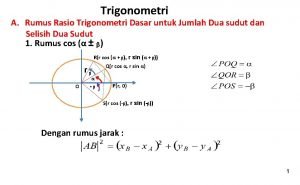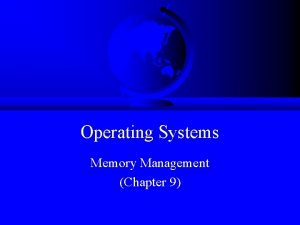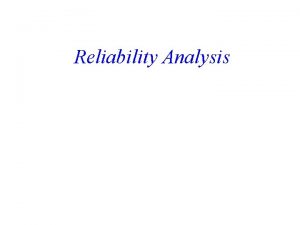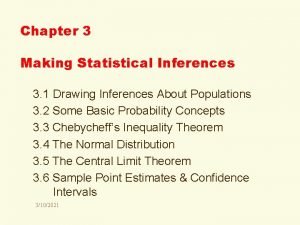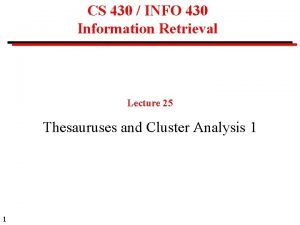Alphanomics Part I The economics of Alpha Rohit














































































































































- Slides: 142

Alphanomics Part I: The economics of Alpha Rohit Beri Mumbai, Jan 2020

Acknowledgement This presentation has been named after the famous Stanford GSB accounting course “ACCT 340 Alphanomics: Informational Arbitrage in Equity Markets” by Prof. Charles M. C. Lee. Author acknowledges the inspiration and the use of content from “Alphanomics: The Informational Underpinnings of Market Efficiency”, a monogram by Lee and So (2014).

Contents The Magic of Markets Efficient Market Hypothesis The Noise Trader Model The Role of Investor Sentiment Valuation Constraints to Arbitrage Alpha Generation

The Role of Markets

The Role of Markets • Hayek (1945): – Economic planning involves two types of knowledge: • Scientific knowledge: knowledge about theoretical or technical principles and rule, and • Specific knowledge: knowledge of particular circumstances of time and place. Technical Knowledge Economic Planning Circumstantial Knowledge

The Role of Markets – Market based economies with decentralized resource allocation will always dominate centralized planning • Efficient social planning depends upon “the utilization of knowledge not given to anyone in its entirety”. • Informational game that central planner cannot hope to win. • North vs South Korea, East vs West Germany, Taiwan vs China. Technical Knowledge Centralized Planning Circumstantial Knowledge Technical Knowledge Circumstantial Knowledge Decentralized Planning

The Role of Markets • Prices: – Helps resource allocation decisions. – Meaningful indicator of relative scarcity. – Price plays an informational role in the market based economies. – Efficiency with which market prices assimilate new information assumes a great importance for the society and the economy. Resource Allocation Scarcity Indicator Prices Market Efficiency Informational Role

The Role of Markets Two key lessons • Informational role of markets in knowledge aggregation is of great value to society. • Asset prices reflect the value of goods/services are central to the development of free market systems Hayek does not talk about how markets become efficient.

Efficient Market Hypothesis

Efficient Market Hypothesis “Markets looks a lot more efficient from the banks of the Charles than from the banks of the Hudson” - Fischer Black, on his move from MIT to GS

Efficient Market Hypothesis Semi-strong • • Public Information Weak Strong • Past Prices • Non-public Information EMH Price Value

Efficient Market Hypothesis • Grossman & Stiglitz (1980): – Information is costly and prices cannot perfectly reflect information which is available – Otherwise no-one would spend resources to obtain it as they will not receive any compensation for the same. – Fundamental conflict between the efficiency with which markets spread information and the incentives to acquire information. • If information costs are nontrivial, some amount of mispricing must remain in equilibrium. Types of Markets Asset Markets Information Markets Exists because costly to evaluate assets and assign fair values Participants incur costs to buy information to profit from it

Efficient Market Hypothesis • Model with information trading but no noise trading doesn’t make sense. (Grossman and Stiglitz, 1980, Black 1986) • Long periods where both equity returns and risky long-term bond returns have been lower than risk free rate (Elton 1999). • News about fundamentals explain only fraction of volatility in returns. (Roll, 19988, Cutler, 1989, Chen et al. 2013) Trading Volume Volatility Cost of Capital Returns Predictability • Firms with lower Beta, lower volatility, lower distress risk, lower leverage, etc. all earn higher returns (Piotroski 2000, Asness 2013) making risk based explanation in-sufficient.

Efficient Market Hypothesis EMH Pillars No limits to arbitrage Rational information processing Complete structural knowledge

Efficient Market Hypothesis Non trivial cost of information Excessive trading volume Excessive volatility of returns Factor loading has little power to explain cross sections returns Realized returns are poor proxy for expected returns The size of active management industry EMH Limitations

Efficient Market Hypothesis • The Price is Right No Free Lunch The Price may or may not be Right

The Noise Trader Model

The Noise Trader Model “Noise trading is trading on noise as if it were information. People who trade on noise are willing to trade even though from an objective point of view they would be better off not trading. Perhaps they think the noise they are trading on is information. Or perhaps they just like to trade. ” - Fischer Black (1986)

The Noise Trader Model Who is a noise trader? Why is existence of noise trading intuitive? We are noise trader whenever we act on a signal that ultimately proves to be valueirrelevant. It is impossible that all traders can instantaneously calibrate the quality of their own signals. Which means we all act as noise trader at some point or other. Noise trading is essential part of price discovery process.

The Noise Trader Model Black (1986) observes that noise trading is the missing ingredient in the traditional model. Explains the enormous volume of trading we observe daily. Explains the continued existence of arbitrage. Noise trading along with non-trivial arbitrage costs also explains the why prices can deviate sharply from fundamental value for persistent periods of time.

The Noise Trader Model • Shiller (1984) – conceptual kernel of behavioural finance. – Important alternative to EMH for understanding market-ricing dynamics. – Model explicitly includes costly information arbitrage leading to mispricing in equilibrium. – Market depicted by the NTM bears a much stronger resemblance to reality than the market depicted by the EMH – NTM recognises that noise trader activities impose a risk on all investors and that this risk increase the cost of capital for everyone in equilibrium. Investor Sentiment Firm Fundamentals Arbitrage Costs Noise Trader Model Noise Trader Arbitrage Costs Equilibrium Mispricing

The Noise Trader Model “Explain asset prices by rational models. Only if all attempts fail, resort to irrational investor behaviour. ” - The Prime Directive: Rubinstein (2001)

The Noise Trader Model Behavioural finance models today do not need to violate the above prime directive. Most models feature noise traders and constrained arbitrage, i. e. rational arbitrage with explicit cost constraints. NTM (Shiller-1984) is one of the earliest examples of such rational behavioural models.

The Noise Trader Model •

The Noise Trader Model •

The Noise Trader Model •

• Markets with low arbitrage costs will feature prices close to fundamentals. – Index futures, closed-end funds and ETFs • Markets with high arbitrage costs will display more volatility and mispricing. – Small cap stocks, less closely followed or less actively traded stocks, growth stocks, emerging market stocks • EMH is a special case of NTM, where arbitrage costs are close to zero. What affects arbitrage costs? The Noise Trader Model Trading Costs Holding Costs Information Costs

The Role of Investor Sentiment

The Role of Investor Sentiment Source of mispricing and thus opportunity for investors. Non-fundamental demand, i. e. net demand for an asset that is not based on an optimal forecast of its fundamental value. Source of risk as it imposes cost on all investors. Investor Sentiment

The Role of Investor Sentiment Market-wide sentiment • Investor sentiment is systemic and pervasive. Firm-wide sentiment • Important in the relative pricing of individual stocks. • Impacts subcategories of stocks such as industries, geographies and investment styles. Research evidence • Multiple liquidity and behavioral based reasons for investor sentiment.

The Role of Investor Sentiment Empirical Research Asset Pricing Literature Models that propose sentiment-based explanation In finance, focus is on market-wide sentiment In corporate finance, impact real economic decisions by managers In accounting, focus in on firm-specific sentiment and characteristic-based mispricing indicators

The Role of Investor Sentiment Humans beings do no function as perfect Bayesians. • Overweight factors such as signal saliency and the ease with which similar events are recalled. • Underweight indicators of statistical reliability. • Affected by complexity, framing, moods, self esteem • Griffin and Tversky (1992), Barberis and Thaler (2002), Shiller (1999), Hirshleifer(2001, 2015) Retail investor Mutual fund investors (passive) Emerging portrait is that of a market buffeted by many types of nonfundamental demand

The Role of Investor Sentiment Common liquidity shock Behavioral biases Origins of Investor Sentiment

The Role of Investor Sentiment In absence of “Arbitrage Costs”, investor sentiment would have no effect on price. Investor Sentiment Inextricably linked Issues such as asset complexity, investor attention and information uncertainty have impact on both. Arbitrage Costs

The Role of Investor Sentiment What moves stock prices? Stock prices react immediately to announcements about company earnings, dividend changes, sales projections, corporate actions, macroeconomic news, regulatory policies, etc. Usually interpreted as support for EMH. Earnings explain only 10% of the variation in returns (Lev (1989), Easton and Harris (1991). Cutler et al. (1989): The stronger claim that market prices only react to fundamental news is not true. The volatility of market returns relative to changes in expected cash flows remains a troubling phenomenon (Shiller 1989, Le. Roy and Potter 1981, Shiller 1988, Enger 2005, Lee & So 2015). Incorporating profitability, growth opportunities and discount rates brings explanatory power to 20% (Chen and Zhang (2007). Including revisions of analysts expectations about earnings takes it to 30% (Leu and Thomas (2000), Copeland et al. (2004) Macroeconomic variables do the equally bad job of explaining realized returns. FX, Bonds and commodity markets have similar issues.

The Role of Investor Sentiment Inter-temporal variations in discount rates have been advanced as main reasons for the unexplained volatility of stock prices. This arguments falls flat when need to rationalize the variations in discount rate. Campbell and Shiller (1988) Elton (1999) Cochrane (2011)

The Role of Investor Sentiment The Quest French and Roll (1986) for Sentiment Shleifer (1986) Trading itself begets volatility in absence of news. Inclusion in the S&P 500 Index leads to price increase by 2 -3%. Barberis et al. (2004) Inclusion in index lead to higher correlation with the index. Lee et al. (1991) Discount on closed-end funds is an individual investor sentiment index. Froot and Dabora (1999) Siamese Twin companies i. e. companies whose stocks trade in different markets comove with the markets on which they trade most.

The Role of Investor Sentiment Behavioral Shiller (1999) roots Hiesheleifer (2001) identifies three main categories of biases Identifies 12 behavioral principles that impacts human decisions under uncertainty. Heuristic simplifications: decision biases that have their root in out limited processing power. Self deceptions: decision biases that are rooted in our need for the preservation of self-esteem. Emotional loss of control: gives rise to set of decision biases rooted in lapses of selfcontrol.

The Role of Investor Sentiment Capital flows and Stock returns • At aggregate level most of the money arrives just before markets decline and exits just before markets rise (Ben-Rephael et al. (2012), Baker and Wurgler (2000), Nelson (1999), Loughran et al. (1994). • Pattern is observed in multiple equity markets around the world (Dichev 2007, Baker et al. 2012) • Uncannily poor timing holds for both individual stocks as well as mutual funds and hedge funds. • Dichev 2007 shows that in most of the developed markets investors actual returns are much lower than the buy and hold returns. • Periods with high (low) equity issuance are followed by low (high) market returns (Baker and Wurgler 2000) • Fung et al. 2008 and Dichev and Yu 2011, show that both mutual fund and hedge funds that experience greater inflows subsequently underperform while funds with greater outflows subsequently outperform. • Annualized returns to hedge-fund investors are 3 -7% lower than buy-and-hold returns earned by the hedge fund (Dichev and Yu 2011). • Firms that issue share experience lower returns and firms repurchasing shares earn higher future returns (Dong et al. 2012, Bradshaw et al. 2006, Mc. Lean et al. 2009). • Puranandam and Swaminathan 2004 conclude that IPO investors are misled by optimistic growth forecasts and paid insufficient attention to profitability in valuing IPOs.

The Role of Investor Sentiment Retail traders • Kumar and Lee 2006 find that retail trades are systematically correlated: individuals buy and sell in concert. • Barber et al. 2009 finds that in Taiwan, individuals collectively suffer an annual performance penalty of 3. 8%, which is equivalent to 2. 2% of Taiwan’s GDP Mutual fund flows • Frazzini and Lamont 2008 and Lou 2012 mutual fund flows effect the prices. • These price effects are relatively long-lived, lasting around two quarters. • Taking several more quarters (or, in the case of Lou, even years) to reverse. • Arif et al. 2015, Akbas et al. 2015, Shive and Yun 2013 show that hedge funds profit from trading against predictable flow induced trades of mutual funds.

The Role of Investor Sentiment Hedge funds and active mutual funds • Rational arbitragers also engage in price destabilizing trades. • De. Long et al. 1990 shows that rational investors may in fact prefer to ride rather than trade against the bubbles. • Popularity of momentum based strategies among hedge funds is well known. Moods and emotions • Impact of sunshine on average stock returns. Cloudy day in New York city correlates with negative NYSE Index returns • Shorter days translates into a greater degree of risk aversion: consequently higher equity returns in fall and winter. Out of phase pattern in Australia. • Edmans et al. 2007 find a significant market decline after soccer losses.

The Noise Trader Model “The affective revolution in psychology of the 1990 s, which elucidated the central role of feelings in decision making, has only partially been incorporated into behavioral finance. More theoretical and empirical study is needed of how feelings affect financial decisions, and the implications of this for prices and real outcomes. This topic includes moral attitudes that infuse decisions about borrowing/saving, bearing risk, and exploiting other market participants. ” - Hirshleifer 2015

The Noise Trader Model “Now the question is no longer, as it was a few decades ago, whether investor sentiment affects stock prices, but rather how to measure investor sentiment and quantify it effects. ” - Baker and Wurgler (2007)

The Role of Investor Sentiment How to measure investor sentiment? Belief revisions Measured by surveys, i. e. consumer confidence Trading decisions Measured by investor fund flows or aggregate trading volumes Price dislocations Measured by comparing price to estimates of fundamental value or perhaps the pricing of IPOs Smart money responses Measure by corporate actions or insider trades

The Role of Investor Sentiment Closed-end fund discount Dividend premium NYSE share turnover Baker and Wurgler (2007) developed a composite index of market-wide sentiment Equity share in new issues Number of IPOs Average first day returns on IPOs Huang et al. (2015) and Arif and Lee (2015) have suggested further refinement of this index.

Valuation

Valuation Value Effect: • Firms trading at lower multiples with stronger balance sheets, more sustainable cash flows, higher profitability, lower volatility, lower beta, and lower distress risk, actually earn higher, not lower future stock returns. • First recognized by famed Columbia University professor, Benjamin Graham and documented as early as 1934. Benjamin Graham as a quant: • Earnings to Price Ratio that is double the AAA bong yield • PE of stock is less than 40% of the average PE for all stocks over the last five years • Dividend yield > Two-thirds of the AAA Corporate Bond Yield • Price < Two-thirds of the Tangible Book Value • Price < Two-thirds of the New Current Asset Value • Debt-Equity Ratio has to be less than 1 • Current Assets > Twice Current Liabilities • Debt < Twice Net Current Assets • Historical Growth in EPS (over last 10 years) > 7% • No more than two years of declining earnings over previous 10 years

Valuation • A modified version of the above strategy designed by Becca Levin (Stanford GSB MBA) and tested on US data from 1999 -2013 produced hedged quintile returns of 9% pa. – Free-cash-flow yield instead of dividend yield – 5 year of past earnings growth instead of 10 years – Assigning score of +1 for each condition met by the firm and dividing the firms in 5 buckets based on scores.

Valuation •

Valuation •

Valuation Cheapness Quality Cheapness Value Investing Quality Market Multiples PVRI vs Price EBIDTA/EV P/B P/E Needs fundamental analysis

Valuation Greenblatt’s Magic Formula (The Little Book That Beats The Market) • Return on Capital (ROC) • Price to Earnings(PE) • Look for companies with history of consistently high past ROC (five 5 years of at least 20% annually) • Buy the ones currently trading at the lowest PEs • The formula works!

Valuation

Valuation • Empirical evidence from academic research: – Cheapness: Value stocks outperform glamour stocks • Book to Market(Stattman 1980, Rosenberg et al. 1985, Fama and French 1992) • Earnings to price (Basu 1977, Reingunum 1981) • Cashflow to price (Lakonishok et al. 1994, Desai et al. 2004) • Sales to EV (O’Shaughnessy 2011) • The strength of value effect varies over time and across stocks but the board tendency is highly robust. Book to Market Earnings to Price Cash-flow to Price Sales to EV

Valuation • Empirical evidence from academic research: – Quality: Firms with high present value of future residual income • Historical ROE – usually priced in. • Piotroski 2000: Firms with better ROAs, operating cashflows etc, outperform the market. F-Score is able to separate winners form losers in low price to book stocks. • Mohanram 2005: Within High price to book firms, those with high growth outperforms those with low growth. G-Score is able to predict such winners and losers. F Score G Score

Valuation – Safety: Safe stocks earn high returns • Lower volatility firms earn higher returns (Falkenstein 2012, Ang et al. 2006) • Lower beta firms earn higher returns (Black et al. 1972, Frazzini and Pedersen 2014) • Firms with lower leverage earn higher returns (George and Hwang 2010, Penman 2007) • Firms with lower level of financial distress also earn higher returns (Campbell 2008). Volatility Beta Leverage Distress

Valuation – Payout: Firma making higher payouts to shareholders & creditors earn higher future returns. • Companies that repurchase their shares tend to outperform (Baker and Wurgler 2002, Pontiff and Woodgate 2008, Mc. Lean 2009) • Firms that issue more shares underperform (Loughran and Ritter 1995, Spiess and Affleck. Graves 1995) Equity

Valuation • Firms that issue more debt earn negative abnormal returns (Spiess and Affleck. Grave 1999, Billett et al. 2006, Daniel and Titman 2006) • Firms that retire their debt earn positive abnormal returns (Affleck-Grave and Miller 2003) • Bradshaw et al. 2006 shows that it is possible to measure these effects using a net external financing activities. Debt Net External Financing

Valuation – Asness et al. 2003 creates a Quality minus Junk portfolio and find the it earns positive risk adjusted returns in 22 out of 23 countries. • Profitability: Bet in favor of high earnings (ROA, ROE), high gross profit (GPOA, GMAR), and high operating cash flows (CFOA, ACC), • Growth: Bet in favor of firms with most positive changes in the above profitability variable over past 5 years. • Safety: Bet against the firms with high Beta, high volatility in returns and earnings, high leverage and high levels of financial distress. • Payout: Bet against firms with high net equity issuance, high net debt issuance, and low net payout ratio over past 5 years.

Valuation Risk based explanations Behavioral based explanations Why does value investing works? Institutional and friction based explanations Preference based explanations

Valuation Risk based explanations • Value stocks are simply riskier (Fama and French 1992). • Vassalou 2003, Chohen et al. 2009, Santos and Veronesi 2010 show that value stocks are more sensitive to economy-wide profitability than growth stocks. • Piotroski and So 2012: When we incorporate measures of quality value investing does not generally does not incur higher risk. Preference based explanations • Some investors have a preference for stocks with lottery-like payoffs. Such stocks will appear over-priced in mean-variance world (Brunnermeier 2007, Bali 2011). • Kumar 2009 shows that this effect particularly applies to retail investors. • If this is true, value effect will persist well into future.

Valuation Institutional and friction based explanations Liquidity driven price pressure For example a fire sale by an asset manager facing redemption can depress the prices of stocks they own, and these stocks subsequently rebound. The impact of these price changes is not specific to value investing, however, it will contribute to higher risk-return ratio for the investors trading on value indicators. Prudent-man concerns Del. Guerico 1996 notes that institutional investors may gravitate toward glamour stocks due to prudent-man concerns, i. e. glamour stocks are easier to justify as sound decisions. Green 2011 and So 2013 show investors equate good companies with good investments Limits to Arbitrage Profiting from value effect can require significant patience and capital deployment. Value firms only tend to gradually rise and glamour firms tend to only gradually fall toward their expected value (Shleifer and Vishny 1997).

Valuation Behavioral based explanations Saliency vs Weight Griffin and Tversky 19992 show that high probability but not salient signals are under-weighted and high salient but low statistical reliability signals are over-weighted. Value firms are boring (non-salient) versus glamour firms (salient). Extrapolation Investors underestimate the mean reversion in the past performance and overestimate the trend. Lakonishok 1994. Dechow and Sloan 1997 shows that analysts tend to fixate on past earning growth when forecasting. Momentum Trading Value stocks tend to be negative momentum stocks, atleast over mid-horizon 3 -12 months. Over-confidence in high information uncertainty settings Jiang et al. 2005 argue that people are overconfident in settings with high information uncertainty. The overweight elements of firm value that are further out in the future and underweight those that are nearer at hand. Evidence in Frankel and Lee 1998 shows that higher forecasted near term earnings can generate higher returns.

Constraints to Arbitrage

Constraints to Arbitrage “One person’s fire sale is another’s buying opportunity. ” - Cochrane (2011)

Constraints to Arbitrage Identify & verify mispricing Costs and risks associated with arbitrage Financing & funding the business Implement & execute the strategy

Constraints to Arbitrage What the smart money sees? • Strategy identification and verification costs are least understood. • Financial markets have limited capability to fully process more complex events. • Agency problems – capital providers will typically not have the same understanding as the professional managers (Shleifer and Vishny 1997). • Even worse for quantitative strategies as back tested strategies are met with skepticism. • Capital may be withdrawn precisely when it is more likely to earn a higher return (Shleifer and Vishny 1997). • Noisy information - sure bet may not be bargain at all (Mitchell et al. 2002) • Lack of good substitute for hedging or less than perfect substitute (LTCM). • Trading costs maybe higher or difficulties in borrowing stocks for shorting (Beneish et al. 2015). • Managing the talent and gauging the right size and scale of the strategy while only having a vague sense of how crowded your investment space has become (Stein 2009, Berk and van Binsbergen 2014).

Constraints to Arbitrage Strategy identification and verification Existence of close substitutes Statistical Arbitrage The Role of Complexity Limited Attention Task complexity Information Uncertainty (IU)

Constraints to Arbitrage Mispricing is easier to identify/verify when close substitutes exists • Closer the substitute, the precisely mispricing can be identified and exploited. • In absence of close substitute, informational arbitrage is inherently risk leading to wide corridor of arbitrage. • Index funds and prices of liquid option generally track theoretical prices; however, technology stocks like Linked. In, Tesla which have no close substitutes can trade at prices far away from sensible values. Statistical Arbitrage • Bet on price reversion between stocks that have similar attributes, e. g. pair trading strategy (Goetzmann & Rouwenhorst 2006) • Others: Negative stub value trades and convertible arbitrage The Role of Complexity • Search costs and task complexity has an impact on the likelihood and the magnitude of mispricing. • Limited Attention • Task complexity • Information Uncertainty (IU)

Constraints to Arbitrage Limited Attention: • Investors do not take into account all relevant information when making decisions. • Prices seems to under react to earning news (Bernard and Thomas, 1990) but overreact to accruals which is a component of earnings (Sloan 1996). • Earning news is processed more fully when there are fewer competing stimulants (Hirshleifer 1992). • In presence of other stimulants, post-earnings price drift is more pronounced. • Even a sports tournament can have a notable effect on market’s ability to fully process earnings (Drake et al. 2015) • Individual investors are particularly prone to attention-driven buying (Barber and Odean 2008). • Da et al. 2011 use the search frequency in Google to develop direct measure of investor attention. Increase in search frequency predicts higher stock prices in the next two weeks and eventual reversal within the year.

Constraints to Arbitrage Task complexity • Kahneman 1973: Attention takes effort. Same can be said for performing complicated tasks. • Some information is subtle and difficult to decipher from the data. • Cohen and Frazzini (2008) show that stock prices of related firms adjust with a lag to new information about their trading partners. • Markets appear to have trouble dealing with more nuanced aspects of news events such as: • Non-routine insider trades (Cohen et al. 2012) • Higher innovation analyst forecast revisions (Gleason and Lee 2003) • More-reliable accrual measures (Richardson et al. 2005) • News related to conglomerate (Cohen and Lou 2012) • Slow-moving demographic data (Della Vigna and Pollet 2007) • More-productive R&D expenses (Cohen et al. 2013) • Gradual past price momentum patterns (Da et al. 2015). • Reported vs disclosed: Less attention to footnotes (Schipper 2007).

Constraints to Arbitrage Information Uncertainty (IU) • Jiang et al. 2005: IU as degree to which a firms value can be reasonably estimated by most knowledgeable investors at reasonable costs. • High IU firms are companies whose expected cash flows are less knowable, perhaps due to the nature of their business or operating environment. • Associated with higher information acquisition cost and less reliable and more volatile fundamental estimates. • High IU firms i. e. firms with higher volatility (Ang et al. 2006), higher trading volume (Lee and Swaminathan 2000), greater expected growth (La Porta 1996), higher price to book (Fama and French 19992), wider dispersion in analyst earnings forecasts (Diether et al. 2002) and longer implied duration in their future cash flows (Dechow et al. 2004), all earn lower subsequent returns. • Jiang et al. 2005, propose behavioral explanation for the IU effect. • Stein 2009, discussed two sources of IU: crowdedness & leverage.

Constraints to Arbitrage Implementation and execution costs Trading costs Fees and commissions - minimal. Bid-ask spreads – not relevant. Price impact – largest cost. Depends on the size, average daily volume, and the urgency. Higher for momentum strategies. Hedging costs Cost of taking an offsetting position Holding costs Cost of carry Short-sale costs Cost of borrowing security Short-sale constraints Leads to overvaluation (Beneish et al. 2015). Lendable shares & costs associated with locating them (Beneish 2015). Even temporary ban impedes pricing efficiency (Bohemer et al. 2012).

Constraints to Arbitrage Funding Access to arbitrage and capital Financing Asset managers often run into financing constraints precisely when arbitrage capital is most needed (Shleifer and Vishny 1997). Investor inflows portends market tops and outflows portends market bottoms (Arif and Lee 2015). Market-wide liquidity constraints Can impact pricing efficiency, limits price discovery through several channels including, reductions in lending, declining collateral needed for leverage and increases in cash reserves to meet redemptions. Funding constraints and asset prices Adrian et al. 2014 shows that as funding constraints tighten, intermediaries are forced to deleverage by selling assets at fire sale prices. Assets that pay off poorly when constraints tighten are risk and must offer high returns. Hanson and Sunderam 2014 show that arbitrage capital is most limited during times when these strategies perform best. However, while returns to arbitrage strategies are real, these strategies will underperform when capital is withdrawn.

Alpha Generation

Alpha Generation Predictability of asset returns • Evidence of predictable returns is often met with controversy. • Fama (1970): Extreme form of market efficiency argues that prices immediately and consistently incorporate all available information and, thus, that any predictable returns must reflect compensation for risk, even if the source of the risk is not readily identifiable. • Investors have inherent interest in distinguishing between the returns that stem from mispricing versus exposure to risk. • Mispricing implies abnormal returns opportunities to be exploited. • Risk based explanations imply that the returns are earned at the expense of the safety.

Alpha Generation Exposure to risk factors – Multi-factor CAPM • French and Fama (1993): • 3 factor portfolio • Excess return on the market (MKT) • The return difference between small and large firms (SMB) • The return difference between high and low book-to-market firms (HML) • Carhart (1997) • Adds another factor to the 3 factor French and Fama approach • Adds price momentum factor defined as the return differential between a portfolio of past winner firms and past losers commonly referred as UMD (short for up-minus-down) • Intercept term in either of the above regressions is the abnormal return to the security or portfolio. • Signals which predicts returns over and above that predicted by factor-based approach, this incremental return is interpreted as being less likely to reflect risk and more likely due to mispricing. Are HML and UMD risk factors or indicators of mispricing? • If latter or mix of both, factor-based tests are over-attributing realized returns to risk based explanations.

Alpha Generation Risk vs Mispricing Post Earnings Announcement Drift (PEAD) Firms with more positive (negative) earning surprise outperform (underperform) the market Piotroski F-Score (2000) Are firms with stronger accounting fundamentals riskier? Accrual anomaly, Ohlson and Bilinski (2015) Analyst Forecasts Are firms with positive earnings surprise getting riskier and firms with negative earnings surprise getting safer? Riskier stocks should experience more extreme jumps in price than safer stocks. Using this approach, accrual anomaly is unlikely to reflect exposure to risk. Investors overweights analysts forecasts and underweight fundamental information (So 2013). Direction of future analyst forecast revisions helps predicts return and can no way be treated as risk factor.

Alpha Generation Sub-periods and subpopulation Statistical significance Economic significance What makes mispricing signal real? Delisting and survivorship biases Size, illiquidity, and exploitability issues

Alpha Generation Sub-periods and sub-population • Signal predicting future returns within a large pooled sample is at best an in-sample fit. • For robust evidence of return predictability, tests confirming the signal across sub-periods and sub-population is required. • Stability across time indicate that results not statistical aberrations. • Very stable signal may also be an indicator of risk-based explanation. • Signal which performs during recessions is unlikely to be a risk-factor. • Stability across population helps determine if the mispricing is concentrated within particular sub-population, e. g. industry, size, etc. • Knowing the sub-population will help determine the implementation costs.

Alpha Generation Delisting and survivorship biases • Delisting and survivorship bias can inflate the return of the strategy. • If which researching a strategy, the return of a delisted firm is take as zero instead of likely negative return, the strategy’s return would be inflated to that extent. • In case of survivorship bias, the sample set is restricted to the firms who are part of the current data set. Firms which went bankrupt or delisted in the past are left out. This leads to an inflated return prediction.

Alpha Generation Size, illiquidity, and exploitability issues • Return predictability does not necessary means availability of economic profits. • For economic profits, the strategy should be product positive risk-adjusted returns after accounting for transactions costs. • Absence of return prediction in large size firms for the strategy maybe the sign of no positive economic profits after transaction costs. Transaction costs tend to be higher for smaller firms and hence the existence of mispricing.

Alpha Generation Economic significance • How much alpha in Rupee terms can an investor extract through careful implementation? • Is predicted annualized return of the strategy high enough for positive risk-adjust economic profits after costs? • Can strategy be implemented across the market and across the time period? Momentum strategies can be implemented across the firms and time period. Whereas earnings surprise only works for the firms with the surprises and around the earning period. • How does the strategy scale, i. e. does strategy remain profitable with the increase in the amount of capital being deployed?

Alpha Generation Statistical significance • Are the predicted returns of the signal/strategy meaningfully different from zero? • Does the significance of signal’s strength exists after taking into account all appropriate risk-factors and other know signals? • One key challenge is the distribution of residuals? Are they independently and identically distributed? • If the residuals are correlated across firms, standard errors maybe understated and will need to be adjusted.

Alpha Generation • Sloan 1996

Alpha Generation – Bhojraj and Swaminathan (2008) find that accrual anomaly is also robust in bond returns – Richardson et al. (2005) expand the definition of accruals to include changes in net financial assets and find that hedged returns increase from 13. 3% pa to 18% pa – Thomas and Zhang (2006) find that inventory accruals exhibit most robust relation with future stock returns – Shi & Zhang (2011) find that accrual hedge returns are higher for firms with lowest relative accrual persistence and higher earnings response coefficient (60% pa) – Dechow (2006): positive returns are higher for low accrual firms with special items Richardson 2005

Alpha Generation • The Analyst Recommendation and Earnings Forecast Anomaly – Recommendation revisions are more valuable that recommendations levels – There are cross-sectional differences in analysts ability to find mispricing – Analysts recommendations have value in markets such as India, Brazil, etc. – Transaction costs significantly reduce the investment value of recommendations – The investment value of recommendations is concentrated primarily on small stocks Recommendations Contra Analyst (Just out of curiosity)

Alpha Generation – Revisions which forecast away form the consensus are more valuable (Gleason and Lee 2003) – Taking into account fundamental characteristics that are bale to predict returns of the covered firms can enhance the profitability of the recommendations – Taking into account the level of accounting accruals can significantly enhance the profitability of forecasts revisions (Barth and Hutton 2004) Revisions+Accruals

Alpha Generation • Post Earnings Announcement Drift (PEAD) – Stock prices drift in the director of earning surprise months after the announcement, a phenomenon referred to as PEAD. – Ray Ball and Philip Brown (1968) found that companies with largest increase (decrease) in earnings during the year also had largest increase(decrease) in the stock price during the year and the stock price of these companies continued to rise(fall) over the 3 months after the announcement. – Foster et al. (1984), Bernard and Thomas (1989), Collins and Hribar (2000), Chordi and Shivakumar (2006), Lerman et al. (2007), Ng et al. (2008), all make the same findings along with the temporal consistency. EPS Surprise Q 1 EPS Surprise Q 2 EPS Surprise Q 3

Alpha Generation – Fama (1998) questions the collective evidence that returns can be predicted but concludes that the evidence on PEAD is above suspicion. – Doyal et al. (2006) records a hedged return of 13. 95% over 12 months, 19. 89% over 24 months, and 23. 69% over 36 months using Analyst forecast error as measure for surprise. – Investors can hold such firm for almost 3 years, thereby reducing the transaction costs. – Part of the return also stems from the fact that current quarter earning surprise is also a predictor of future earning surprises. – Taylor (2010) finds that drift is concentrated in stocks where retail investors trade contrarian to the earnings surprise. EPS Surprise Q 4 EPS Revisions Composite

Alpha Generation • F Score G Score Composite

Alpha Generation – Dichev (1998) and Campbell et al. find that firms with high bankruptcy risk underperforms the firms with low bankruptcy risk based on Z-Score or O-Score and generate hedged returns between 12 and 23%. – Abarbanell and Bushee (1998) find negative relation between capex and future returns. Titman et al (2004) find that investors tend to underreact to empire building implication. Distress Composite Capital Expenditure

Alpha Generation • Net Stock Anomaly – IPOs and SEOs • • Ritter (1993) finds that IPOs underperform their peers over 3 year period. Teoh et al. (1998) hints at earnings management before IPO by the issuing firm. Schultz (2003) shows that IPOs are expected to underperform even in an efficient markets due to concentration. Similar results for seasoned equity offerings. Equity Issuance Equity Buyback – Share Repurchases and Tender Offers • • • Lakonishok and Vermaelen (2000) find that repurchasing firms outperform the market. The returns are mainly concentrated in small firms. , large firm experience positive abnormal stocks returns before the announcement and zero afterwards. Peyer and Vermaeken (2009) find that anomaly exists over time and that firms who repurchase shares are exploiting undervaluation. – Private Equity Placement • Hertzel et al. (2002) documents similar findings for private equity placements in public companies as in case of IPOs. Net Equity Issued

Alpha Generation – Debt Issuances • Spiess and Affleck-Graves (1999) finds that debt issuances are associated with underperformance over next 5 years period. • Results more pronounced for smaller and younger firms. • Underperformance is even higher for convertible issuances. • Affleck-Grave and Miller (2003) finds that firm which call their debt or convertible notes outperform the market over 5 year period. • Billett et al. (2006) finds similar relationship in case of bank loans as well. Debt Issuance Debt Buyback Net Debt Issued

Alpha Generation – Net External Financing • • Bradshaw et al. (2006) finds next external financing to be even stronger predictor of returns. Investors do not correctly infer the negative relation between financing activities and future performance. – Dividend Initiation and Omissions • • Michaely et al. (1995) finds significant positive stock price reaction to the announcements of initiating dividends and significant negative reaction to dividend omissions. Magnitude is asymmetric as it is greater for dividend omission in year 1. The anomaly persists for 3 year period with roughly 24. 8% returns for initiation and -15. 3% for the omissions. Post dividend drift is distinct and more pronounced that PEAD. Net External Financing Dividend Yield Dividend Initiation Dividend Omission – Merger and Acquisitions • • Agarwal et al. (1992) and Schwert (1996) finds that firms in mergers generate negative abnormal stock returns on 10. 26% over 5 year period. Cash acquisitions perform better than mergers & high P/B acquirers fare worse. (Rau 98)

Alpha Generation • Insider Trading Anomaly – Lorie and Niederhoffer (1968) was firm to discover insider anomaly and Jaffe (1974) was first to show that outsiders can profit from the same as well. – Seyhun (1986) finds the hedged returns of 6. 5% over the 300 day period. – Jeng et al. (2003) show that in case of intense insider trading, the returns are much higher at 20%+ over a year. – More return information in insider purchases than in insider sales. Insider Purchases Insider Sales Buy Transactions Sell Transactions

Alpha Generation – Liu and Yermack (2007) find that some insiders illegally sell their stocks when they know about earnings management, upcoming negative earnings surprise or possible bankruptcy. However, most inside sales are not very informative. – Sias (2008) found that institutions usually trade in the opposite direction as insiders, who are contrarians. – Institutional investors can take advantage of the anomaly in large and mid caps. Individuals can even make abnormal profits in small caps. – Higher return in case of industries with information asymmetry, e. g. Technology. Net Insider Purchases Net Insider Transactions % Insider Purchases % Net Insider Purchases

Alpha Generation • Momentum Anomaly – Lo et al. (2000): The seminal paper for the first time showed that some of the technical indicators do, in fact, have a practical value. – De. Bondt and Thaler (1985) find strong evidence that good performing stocks become poor performers over 3 -year and 5 year holdings and viceversa. 36/36 hedge portfolio returning 24. 6% over 36 months but most of the returns comes from prior losers. 2 Years 3 Years Contra 3 Years Moving Average Contra

Alpha Generation – Jegadeesh and Titman (1993) perform similar analysis but with a focus on shorter-term investment horizon and find in the 3 -12 months time horizon, winner portfolio continues to outperform the loser portfolio. – They also find evidence that returns exhibit reversals within 1 month. – Here again most of the performance comes from the long side but with winners continuing to perform strongly. – Hong et al. (2000) finds that momentum anomaly shrinks with the increase in firm’s size and also with increase in analyst coverage. 3 Days Contra 15 Days Contra 26 Weeks 52 Weeks

Alpha Generation – French and Fama (1996) conclude that returns from short/medium term momentum strategies are profitable after risk adjusted basis. – Arena et al. (2008) find that momentum strategies produce better return when trading high i. Vol stocks (i. Vol is std. dev. of residuals when regressing returns of the stock against broader market and is used as proxy to measure under-reaction to firm-specific news). – Other indicators: Moving averages (stronger than momentum), 52 W High/Low, Short Interest, etc. 3 M Average Volume 13 Weeks Daily Moving Average 52 Weeks High/Low Short Interest

Alpha Generation • Size anomaly – Banz (1981), first to document size anomaly, showed that the smallest 20% of the firms earn an annual return that us almost 5% higher than the return on other firms. – Fama-French (1993) consider size anomaly as return to risk factor and has incorporated the same in there 3 -factor model as SMB (return difference between small stocks and large stocks portfolios).

Alpha Generation – Stoll and Whaley (1983) show that for NYSE stocks size anomaly disappears when bid-ask spread is taking into account and that it actually represents a compensation for illiquidity. Schultz (1983) counters them by arguing that size anomaly is intact when NYSE and AMEX stocks are considered together. – Fama-French (2008) show that size anomaly owes much of its power to micro cap stocks, and within microcaps, tinier stocks have higher average returns. – Keim (1983) finds the almost 50% of the size effect is due to January effect. The same was confirmed by Daniel and Titman (1997). S&P 500 S&P 1500

Alpha Generation – Demirtas and Guner (2008) find that bulk of the size effect is attributable to firms with poor past earnings relative to expectations. Investors overreact to the bad new by overselling the stocks with poor past performance. Size EPS Surprise + Size

Alpha Generation • Value anomaly – Tendency of value stocks to outperform growth stocks and dates back to Benjamin and Dodd. – Formal test for value anomaly was performed by Basu (1977) using E/P and by Stattman (1980) and Rosenberg (1985) using B/P as a value indicator. – Fama-French (1993) consider value anomaly as return to risk factor and has incorporated the same in there 3 factor model as HML (return difference between High Book to Market and Low Book to Market portfolios). – Lakonishok et al. (1994) finds that value stocks do not underperform growth stocks during bad states of the world and hence risk-based explanations cannot be justified.

Alpha Generation – Hoberg and Welch (2009) show that Fama. French factors cannot price optimized test portfolios and the abnormal returns are economically significant and robust. – Dichev (1998) used Z-Score and finds that bankruptcy risk is not rewarded by higher returns, contrary to Fama-French risk based explanations. – Loughran and Wellman (2010) finds that EV/EBIDTA multiple has similar abilities to predict returns and this power survives even after controlling for P/B. – Petkova and Zhang (2005) finds that value premium varies counter-cyclically; premium increases during recessionary periods. – Rytchkov (2010) shows that Kalman filter technique can be used for predicting future value premium from past vale spreads. EP + EBIDTA/EV + Sales/EV

Alpha Generation January effect Open/Close daily trade on the Open January Barometer Seasonal Anomaly Sunshine and Weather effect Holiday effects Sell in May and go away Turn of the month (TOM)

Alpha Generation January effect • Tendency of small stocks to outperform large cap stocks in the month of January. • Easterday et al. (2008) find that January effect continues to be robust. January Barometer • Hirsch (1986) finds that returns in January have been valuable signal for the returns in the following 11 months. • If stocks have positive returns in January, then it is likely that the market as a whole will rise in that year. Turn of the month (TOM) • Lakonishok and Smidt (1988) and Sick and Ziemba (1994) found that for large caps and value line small caps, 2/3 rd of the months gain occur of trading days -1 to +4. • Rest of the gains occur on +5 to +9 and the second half was at best, noise. Sell in May and go away • Sept and Oct have historically had low returns and Nov to Feb have historically had higher than average returns (Gultekin (1983), Keim and Ziemba (2000))

Alpha Generation Holiday effects • Ariel (1990), Zweig (1986), Lakonishok and Smidt (1988) document this anomaly. • 50%+ non-dividend returns on Dow Jones Index were made on 8 yearly pre-holidays. • -3 trading day have the highest returns. Sunshine and Weather effect • Sunshine is strongly positively correlated with daily stocks returns (Hirschleifer and Shumway 2003). • The effect is monotone stronger the further one is from the equator and the per capita GDP (Keef and Roush 2000). Open/Close daily trade on the Open • Branch et al. (2006) find a very strong negative autocorrelation between the overnight return (between the close and the next day open) and the intraday return (return during the day while market is open). • This anomaly contradicts the weak form of the efficient market hypothesis. • Cooper et al. (2008) show that majority of returns are made when markets are closed with intraday returns being close to zero.

Alpha Generation Investment Strategy Example Decile Performance

Alpha Generation

Alpha Generation

Contact Rohit Beri rberi@alumni. stanford. edu +65 8386 0191 +91 98197 91602

Appendix

References • • • • V. V. Acharya and L. Pedersen. Asset pricing with liquidity risk. Journal of Financial Economics , 77: 375– 410, 2005. T. Adrian, E. Etula, and T. Muir. Financial intermediaries and the cross section of asset returns. Journal of Finance , 69: 2557– 2596, 2014. J. Affleck-Graves and R. Miller. The information content of calls of debt: Evidence from long-run stock returns. Journal of Financial Research , 26: 421– 447, 2003. A. Ahmed, E. Kilic, and G. Lobo. Does recognition versus disclosure matter? evidence from value-relevance of banks’ recognized and disclosed derivative financial instruments. The Accounting Review , 81: 567– 588, 2006. F. Akbas, W. J. Armstrong, S. Sorescu, and A. Subrahmanyam. Smart money, dumb money, and capital market anomalies. Journal of Financial Economics, 118: 355– 382, 2015. E. Altman. Financial ratios, discriminant analysis, and the prediction of corporate bankruptcy. Journal of Finance , 23: 589– 609, 1968. Y. Amihud and H. Mendelson. Asset pricing and the bid-ask spread. Journal of Financial Economics , 17: 223– 249, 1986. S. Anderson and J. Born. Closed-end fund pricing: Theory and evidence. In The Innovations in Financial Markets and Institutions series , Springer, 2002. A. Ang, R. Hodrick, Y. Xing, and X. Zhang. The cross-section of volatility and expected returns. Journal of Finance , 61: 259– 299, 2006. J. Ang and S. Zhang. Evaluating long-horizon event study methodology. In Handbook of Financial Econometrics and Statistics , Springer, New York, 2015. S. Arif and C. Lee. Aggregate investment and investor sentiment. Review of Financial Studies , 2015. Forthcoming. S. Arif, A. Ben-Rephael, and C. Lee. Do short-sellers profit from mutual funds? evidence from daily trades. Working paper, University of Indiana and Stanford University, 2015.

References • • • • H. Arkes, L. Herren, and A. Isen. The role of potential loss in the influence of affect on risk-taking behavior. Organizational Behavior and Human Decision Processes , 42: 181– 193, 1988. C. Asness and J. Liew. The great divide over market efficiency. Institutional Investor , 2014. URL http: //www. institutionalinvestor. com/Article/3315202/Asset-Management-Equities/The-Great-Divide-over-Market. Efficiency. html#. U 6 m 8 gfld. XAk. C. Asness, A. Frazzini, and L. Pedersen. Quality minus junk. Working paper, AQR Capital Management and New York University, 2013. C. Asness, A. Frazzini, R. Israel, and T. Moskowitz. Fact, fiction, and momentum investing. Journal of Portfolio Management , 40: 75– 92, 2014. P. Asquith, P. A. Pathak, and J. R. Ritter. Short interest, institutional ownership, and stock returns. Journal of Financial Economics , 78: 243– 276, 2005. M. Bagnoli, M. B. Clement, and S. G. Watts. Around-the-clock media coverage and the timing of earnings announcements. Working Paper, Purdue University, 2005. M. Baker and J. Wurgler. The equity share in new issues and aggregate stock returns. Journal of Finance , 55: 2219– 2257, 2000. M. Baker and J. Wurgler. Market timing and capital structure. Journal of Finance , 57: 1– 32, 2002. M. Baker and J. Wurgler. Investor sentiment and the cross-section of stock returns. Journal of Finance , 61: 1645– 1680, 2006. M. Baker and J. Wurgler. Investor sentiment in the stock market. Journal of Economic Perspectives , 21: 129– 151, 2007. M. Baker and J. Wurgler. Behavioral corporate finance: An updated survey. In Handbook of the Economics of Finance, Volume 2. Elsevier Press, 2012. M. Baker, J. Wurgler, and Y. Yuan. Global, local, and contagious investor sentiment. Journal of Financial Economics , 104: 272 – 287, 2012. References 235 T. G. Bali, N. Calcici, and R. F. Whitelaw. Maxing out: Stocks as lotteries and the cross-section of expected returns. Journal of Financial Economics, 99: 427– 446, 2011. B. Barber and J. Lyon. Detecting long-run abnormal stock returns: The empirical power and specification of test statistics. Journal of Financial Economics , 43: 341– 372, 1997.

References • • • • B. Barber and T. Odean. All that glitters: The effect of attention and news on the buying behavior of individual and institutional investors. Review of Financial Studies , 21: 785– 818, 2008. B. Barber and T. Odean. The behavior of individual investors. In Handbook of the Economics of Finance, Volume 2. Elsevier Press, 2015. B. Barber, Y. Lee, Y. Liu, and T. Odean. Just how much do individual investors lose by trading? Review of Financial Studies , 22: 609– 632, 2009 a. B. Barber, T. Odean, and N. Zhu. Do retail trades move markets? Review of Financial Studies , 22: 151– 186, 2009 b. N. Barberis. Thirty years of prospect theory in economics: A review and assessment. Journal of Economic Perspectives , 27: 173– 196, 2013. N. Barberis and M. Huang. Stocks as lotteries: The implications of probability weighting for security prices. American Economic Review , 98: 2066– 2100, 2008. N. Barberis and A. Shleifer. Style investing. Journal of Financial Economics , 68: 161– 199, 2003. N. Barberis and R. Thaler. A survey of behavioral finance. In Handbook of the Economics of Finance. Elsevier Press, 2002. N. Barberis, A. Shleifer, and R. Vishny. A model of investor sentiment. Journal of Financial Economics , 49: 307– 343, 1998. N. Barberis, M. Huang, and T. Santos. Prospect theory and asset prices. Quarterly Journal of Economics , 116: 1– 53, 2001. N. Barberis, A. Shleifer, and J. Wurgler. Comovement. Journal of Financial Economics , 75: 283– 317, 2004. N. Barberis, R. Greenwood, L. Jin, and A. Shleifer. X-capm: An extrapolative capital asset pricing model. Journal of Financial Economics , 115: 1– 24, 2015. M. Barth, W. Beaver, and W. Landsman. The relevance of the value relevance literature for financial accounting standard setting: Another view. Journal of Accounting and Economics , 31: 77– 104, 2001. 236 References S. Basu. The investment performance of common stocks in relation to their price-to-earnings: A test of the efficient markets hypothesis. Journal of Finance , 32: 663– 682, 1977.

References • • • L. A. Bebchuk, A. Cohen, and C. C. Y. Wang. Learning and the disappearing association between governance and returns. Journal of Financial Economics , 108: 323– 348, 2013. A. Ben-Rephael, S. Kandel, and A. Wohl. Measuring investor sentiment with mutual fund flows. Journal of Financial Economics , 104: 363– 382, 2012. M. Beneish. The detection of earnings manipulation. Financial Analysts Journal , 55: 24– 36, 1999. M. Beneish, C. Lee, and C. Nichols. Earnings manipulation and expected returns. Financial Analysts Journal , 69: 57– 82, 2013. M. Beneish, C. Lee, and C. Nichols. In short supply: Short-sellers and stock returns. Journal of Accounting and Economics , 2015. Forthcoming. J. Berk and R. C. Green. Mutual fund flows and performance in rational markets. Journal of Political Economy , 112: 1269– 1295, 2004. J. Berk and J. van Binsbergen. Measuring skill in the mutual fund industry. Journal of Financial Economics , 2014. Forthcoming. V. Bernard. The Feltham-Ohlson framework: Implications for empiricists. Contemporary Accounting Research , 11: 733– 747, 1995. V. Bernard and K. Schipper. Recognition and disclosure in financial reporting. Working paper, University of Michigan and University of Chicago, 1994. V. Bernard and J. K. Thomas. Evidence that stock prices do not fully reflect the implications of current earnings for future earnings. Journal of Accounting and Economics , 13: 305– 341, 1990. S. Bhojraj and C. Lee. Who is my peer? A valuation-based approach to the selection of comparable firms. Journal of Accounting Research , 40: 407– 439, 2002. M. Billett, M. Flannery, and J. Garfinkel. Are bank loans special? Evidence on the post-announcement performance of bank borrowers. Journal of Financial and Quantitative Analysis , 41: 733– 751, 2006.

References • • • • F. Black. Presidential address: Noise. Journal of Finance , 41: 529– 543, 1986. References 237 F. Black, M. Jensen, and M. Scholes. The capital asset pricing model: Some empirical tests. In Studies in the Theory of Capital Markets , pages 79– 121, Praeger, New York, 1972. E. Blankespoor. The impact of information processing costs on firm disclosure choice: Evidence from the XBRL mandate. Working paper, Stanford University, 2013. J. Blocher, A. Reed, and E. Van Wesep. Connecting two markets: An equilibrium framework for shorts, longs, and stock loans. Journal of Financial Economics , 108: 302– 322, 2013. J. Bodurtha, D. Kim, and C. Lee. Closed-end country funds and u. s. market sentiment. Review of Financial Studies , 8: 879– 918, 1995. E. Boehmer and J. J. Wu. Short selling and the price discovery process. Review of Financial Studies , 26: 287– 322, 2013. E. Boehmer, C. M. Jones, and X. Zhang. Shackling the short sellers: The 2008 shorting ban. Working paper, Singapore Management University, Columbia Business School, and Purdue University, 2012. B. Boyer. Style-related comovements: Fundamentals or labels? Journal of Finance , 66: 307– 322, 2011. M. Bradshaw, S. Richardson, and R. Sloan. The relation between corporate financing activities, analysts’ forecasts and stock returns. Journal of Accounting and Economics , 42: 53– 85, 2006. A. Brav and P. A. Gompers. Myth or reality? The long-run underperformance of initial public offerings: Evidence from venture capital and nonventure capital-backed companies. Journal of Finance , 52: 1791– 1822, 1997. A. Bris, W. N. Goetzmann, and N. Zhu. Efficiency and the bear: Short sales and markets around the world. Journal of Finance , 62: 1029– 1079, 2007. N. Brown, K. Wei, and R. Wermers. Analyst recommendations, mutual fund herding, and overreaction in stock prices. Management Science , 60: 1– 20, 2013. M. K. Brunnermeier and S. Nagel. Hedge funds and the technology bubble. Journal of Finance , 59: 2013– 2040, 2004.

References • • • • M. K. Brunnermeier and A. Parker. Optimal expectations. American Economic Review , 95: 1092– 1118, 2005. M. K. Brunnermeier and L. Pedersen. Market liquidity and funding liquidity. Review of Financial Studies , 22: 2201– 2238, 2009. 238 References M. K. Brunnermeier, C. Gollier, and A. Parker. Optimal beliefs, asset prices, and the preference for skewed returns. American Economic Review , 97: 159– 165, 2007. A. C. Call, M. Hewitt, T. Shevlin, and T. L. Yohn. Firm-specific estimates of differential persistence and their incremental usefulness forecasting and valuation. The Accounting Review , 2015. forthcoming. J. Campbell. A variance decomposition for stock returns. Economic Journal , 101: 157– 179, 1991. J. Campbell. Empirical asset pricing: Eugene Fama, Lars Peter Hansen, and Robert Shiller. Working Paper, Harvard University and NBER, 2014. J. Campbell and A. Kyle. Smart money, noise trading, and stock price behavior. Review of Economic Studies , 60: 1– 34, 1993. J. Campbell and R. Shiller. Cointegration and tests of present value models. Journal of Political Economy , 95: 1062– 1087, 1987. J. Campbell and R. Shiller. The dividend-price ratio and expectations of future dividends and discount factors. Review of Financial Studies , 1: 195– 228, 1988 a. J. Campbell and R. Shiller. Stock prices, earnings, and expected dividends. Journal of Finance , 43: 661– 676, 1988 b. J. Campbell, J. Hilscher, and J. Szilagyi. In search of distress risk. Journal of Finance , 63: 2899– 2939, 2008. J. Campbell, C. Polk, and T. Vuolteenaho. Growth or glamour? Fundamentals and systematic risk in stock returns. Review of Financial Studies , 23: 306– 344, 2010. M. Cao and J. Wei. Stock market returns: A note on temperature anomaly. Journal of Banking and Finance , 29: 1559– 1573, 2005. M. Carhart. On persistence in mutual fund performance. Journal of Finance , 52: 57– 82, 1997.

References • • • • M. Carlson, A. Fisher, and R. Giammarino. Corporate investment and asset price dynamics: Implications for seo event studies and long-run performance. Journal of Finance , 61: 1009– 1034, 2006. J. Cassidy. Annals of money: The price prophet. The New Yorker , February 7 2000. G. Cespa and T. Foucault. Illiquidity contagion and liquidity crashes. Review of Financial Studies , 27: 1615– 1660, 2014. References 239 K. Chan, P. H. Hendershott, and A. B. Sanders. Risk and return on real estate: Evidence from equity reits. AREUEA Journal , 18: 431– 452, 1990. L. Chan, N. Jegadeesh, and J. Lakonishok. Momentum strategies. Journal of Finance , 51: 1681– 1713, 1996. S. Chava and A. Purnanadam. Is default risk negatively related to stock returns? Review of Financial Studies , 2009. Forthcoming. L. Chen, Z. Da, and X. Zhao. What drives stock price movements? Review of Financial Studies , 26: 841– 876, 2013. N. Chen, R. Roll, and S. Ross. Economic forces and the stock market. Journal of Business , 59: 383– 403, 1986. N. Chen, R. Kan, and M. Miller. Are discounts on closed-end funds a sentiment index? Journal of Finance , 48: 795– 800, 1993 a. N. Chen, R. Kan, and M. Miller. A rejoinder. Journal of Finance , 48: 809– 810, 1993 b. P. Chen and G. Zhang. How do accounting variables explain stock price movements? Theory and evidence. Journal of Accounting and Economics, 43: 219– 244, 2007. M. Cherkes. Closed-end funds: A survey. Annual Review of Financial Economics, 4: 431– 445, 2012. J. Chevalier and G. Ellison. Risk taking by mutual funds as a response to incentives. Journal of Political Economy , 105: 1167– 1200, 1997. N. Chopra, C. Lee, A. Shleifer, and R. Thaler. Yes, closed-end fund discounts are a sentiment index. Journal of Finance , 48: 801– 808, 1993 a.

References • • • • N. Chopra, C. Lee, A. Shleifer, and R. Thaler. Summing up. Journal of Finance , 48: 811– 812, 1993 b. S. Christoffersen, D. Musto, and R. Wermers. Investor flows to asset managers: Causes and consequences. Annual Review of Financial Economics , 6: 289– 310, 2014. J. Claus and J. Thomas. Equity premia as low as three percent? Empirical evidence from analysts’ earnings forecasts for domestic and international stock markets. Working paper, Columbia University, 2000. J. H. Cochrane. Production-based asset pricing and the link between stock returns and economic fluctuations. Journal of Finance , 46: 209– 37, 1991. J. H. Cochrane. Presidential address: Discount rates. Journal of Finance , 66: 1047– 1108, 2011. 240 References L. Cohen and A. Frazzini. Economic links and limited attention. Journal of Finance , 63: 1977– 2011, 2008. L. Cohen and D. Lou. Complicated firms. Journal of Financial Economics, 91: 383– 400, 2012. L. Cohen, C. Malloy, and L. Pomorski. Decoding inside information. Journal of Financial Economics , 91: 1009– 1043, 2012. L. Cohen, K. Diether, and C. Malloy. Misvaluing innovation. Review of Financial Studies , 2013 a. Forthcoming. L. Cohen, K. Diether, and C. Malloy. Legislating stock prices. Journal of Financial Economics , 2013 b. Forthcoming. R. B. Cohen, C. Polk, and T. Vuolteenahu. The price is (almost) right. Journal of Finance , 64: 2739– 2782, 2009. T. Copeland, A. Dolgoff, and A. Moel. The role of expectations in explaining the cross-section of stock returns. Review of Accounting Studies , 9: 149– 188, 2004. S. Cottle, R. Murray, and F. Block. Graham and Dodd’s Security Analysis, Fifth Edition. Mc. Graw-Hill Book Company, 1988. J. Coval and E. Stafford. Asset fire sales (and purchases) in equity markets. Journal of Financial Economics , 86: 479– 512, 2007. J. D. Coval, D. A. Hirshleifer, and T. Shumway. Can individual investors beat the market? Working paper, Harvard University, 2005.

References • • • • D. Cutler, J. Poterba, and L. Summers. What moves stock prices? Journal of Portfolio Management , 15: 4– 12, 1989. Z. Da and M. Warachka. Cashflow risk, systematic earnings revisions, and the cross-section of stock returns. Journal of Financial Economics , 94: 448– 468, 2009. Z. Da, J. Engelberg, and P. Gao. In search of attention. Journal of Finance , 66: 1461– 1499, 2011. Z. Da, U. G. Gurun, and M. Warachka. Frog in the pan: Continuous information and momentum. Review of Financial Studies , 27: 2171– 2218, 2015. A. Damodaran. Value investing: Investing for grown ups? Working paper, NYU, 2012. K. Daniel and S. Titman. Evidence on the characteristics of cross-sectional variation in common stock returns. Journal of Finance , 52: 1– 33, 1997. K. Daniel and S. Titman. Market reactions to tangible and intangible information. Journal of Finance , 61: 1605– 1643, 2006. References 241 K. Daniel, M. Grinblatt, S. Titman, and R. Wermers. Measuring mutual fund performance with characteristic-based benchmarks. Journal of Finance , 52: 1035– 1058, 1997. K. Daniel, D. Hirshleifer, and A. Subrahmanyam. Investor psychology and security market under- and overreactions. Journal of Finance , 53: 1839– 1886, 1998. K. Daniel, D. Hirshleifer, and A. Subrahmanyam. Overconfidence, arbitrage, and equilibrium asset pricing. Journal of Finance , 56: 921– 965, 2001. H. Daouk, C. M. C. Lee, and D. Ng. Capital market governance: How do security laws affect market performance? Journal of Corporate Finance, 12: 560– 593, 2006. G. D’Avolio. The market for borrowing stocks. Journal of Financial Economics, 66: 271– 306, 2002. DBEQS Global, 2014. Academic Insights Month Report, Deutsche Bank Equity Quantitative Strategy Global. W. De. Bondt and R. Thaler. Does the stock market overreact? Journal of Finance , 40: 793– 805, 1985.

References • • • W. De. Bondt and R. Thaler. Further evidence of investor overreaction and stock market seasonality. Journal of Finance , 42: 557– 581, 1987. P. Dechow and R. Sloan. Returns to contrarian investment strategies: Tests of naive expectations hypotheses. Journal of Financial Economics , 43: 3– 27, 1997. P. Dechow, A. Hutton, and R. Sloan. An empirical assessment of the residual income valuation model. Journal of Accounting and Economics , 26: 1– 34, 1999. P. Dechow, A. Hutton, L. Meulbroek, and R. Sloan. Short-sellers, fundamental analysis, and stock returns. Journal of Financial Economics , 61: 77– 106, 2001. P. Dechow, R. Sloan, and M. Soliman. Implied equity duration: A new measure of equity security risk. Review of Accounting Studies , 9: 197– 228, 2004. D. Del Guercio. The distorting effect of the prudent-man laws on institutional equity investments. Journal of Financial Economics , 40: 31– 62, 1996. S. Della Vigna and J. Pollet. Demographics and industry returns. American Economic Review , 97: 1667– 1702, 2007. S. Della Vigna and J. Pollet. Investor inattention and Friday earnings announcements. Journal of Finance , 64: 709– 749, 2009. 242 References J. De. Long, A. Shleifer, L. H. Summers, and R. J. Waldmann. Noise trader risk in financial markets. Journal of Political Economy , 98: 703– 738, 1990 a. J. De. Long, A. Shleifer, L. H. Summers, and R. J. Waldmann. Positive feedback investment strategies and destabilizing rational speculation. Journal of Finance , 45: 379– 395, 1990 b. E. Demers and C. Vega. Linguistic tone in earnings press releases: News or noise? Working paper, INSEAD and the Board of Governors of the Federal Reserve System, 2011. D. K. Denis, J. J. Mc. Connell, A. V. Ovtchinnikov, and Y. Yu. S&p 500 index additions and earnings expectations. Journal of Finance , 58: 1821– 1840, 2003.

References • • • H. Desai, K. Ramesh, S. R. Thiagarajan, and B. V. Balachandran. An investigation of the informational role of short interest in the nasdaq market. The Journal of Finance , 57: 2263– 2287, 2002. H. Desai, S. Rajgopal, and M. Venkatachalam. Value-glamour and accrual based market anomalies: One anomaly or two? The Accounting Review , 79: 355– 385, 2004. D. Diamond and R. E. Verrecchia. Information aggregation in a noisy rational expectations economy. Journal of Financial Economics , 9: 221– 236, 1981. I. Dichev. Is the risk of bankruptcy a systematic risk? Journal of Finance , 53: 1131– 1147, 1998. I. Dichev. What are stock investors’ actual historical returns? Evidence from dollar-weighted returns. American Economic Review , 97: 386– 401, 2007. I. Dichev and G. Yu. Higher risk, lower returns: What hedge fund investors really earn. Journal of Financial Economics , 100: 248– 263, 2011. K. Diether, C. Malloy, and A. Scherbina. Differences of opinion and the crosssection of stock returns. Journal of Finance , 57: 2113– 2141, 2002. M. Dong, D. Hirshleifer, and S. H. Teoh. Overvalued equity and financing decisions. Review of Financial Studies , 25: 3645– 3683, 2012. J. Doukas, C. Kim, and C. Pantzalis. A test of the errors-in-expectations explanation of the value/glamour stock returns performance: Evidence from analysts’ forecasts. Journal of Finance , 57: 2143– 2165, 2002. M. Drake, L. Rees, and E. Swanson. Should investors follow the prophets or the bears? Evidence on the use of public information by analysts and short sellers. The Accounting Review , 86: 101– 130, 2011. References 243 M. Drake, K. Gee, and J. Thornock. March market madness: The impact of value-irrelevant events on the market pricing of earnings news. Contemporary Accounting Research , 2015. Forthcoming. T. Dyckman and D. Morse. Efficient Capital Markets: A Critical Analysis. Prentice-Hall, Englewood Cliffs, N. J, 2 nd edition, 1986.

References • • • • D. Easley and M. O’Hara. Information and the cost of capital. Journal of Finance , 59: 1553– 1583, 2004. P. Easton. PE ratios, PEG ratios, and estimating the implied expected rate of return on equity capital. The Accounting Review , 79: 73– 96, 2004. P. Easton and T. Harris. Earnings as an explanatory variable for returns. Journal of Accounting Research , 29: 19– 36, 1991. P. Easton, T. Harris, and J. Ohlson. Aggregate accounting earnings can explain most of security returns. Journal of Accounting and Economics , 15: 119– 142, 1992. A. Edmans, D. Garcia, and O. Norli. Sports sentiment and stock returns. Journal of Finance , 62: 1967– 1998, 2007. E. Edwards and P. Bell. Theory and Measurement of Business Income. University of California Press, Berkeley, CA, 1961. D. Ellsberg. Risk, ambiguity, and the savage axioms. Quarterly Journal of Economics , 75: 643– 699, 1961. E. Elton. Presidential address: Expected return, realized return, and asset pricing tests. Journal of Finance , 54: 1199– 1220, 1999. C. Engel. Some new variance bounds for asset prices. Journal of Money, Credit, and Banking , 37: 949– 955, 2005. J. Engelberg. Costly information processing: Evidence from earnings announcements. Working paper, Northwestern University, 2008. J. Engelberg, A. V. Reed, and M. C. Ringgenberg. How are shorts informed? Short sellers, news, and information processing. Journal of Financial Economics, 105: 260– 278, 2012 a. J. Engelberg, C. Sasseville, and J. Williams. Market madness? The case of mad money. Management Science , 58: 351– 364, 2012 b. R. Engle, R. Ferstenberg, and J. Russell. Measuring and modeling execution cost and risk. Journal of Portfolio Management , 38: 14– 28, 2012. E. Eyster, M. Rabin, and D. Vayanos. Financial markets where traders neglect the information content of prices. Working paper, London School of Economics and UC Berkeley, 2013. 244 References

References • • • • F. J. Fabozzi, editor. Short selling: Strategies, risks, and rewards. Wiley and Sons, Hoboken, NJ, 2004. E. Falkenstein. The missing risk premium: Why low volatility investing works. Working paper, Eric G. Falkenstein, 2012. E. Fama. The behavior of stock market prices. Journal of Business , 38: 34– 105, 1965. E. Fama. Efficient capital markets: A review of theory and empirical work. Journal of Finance , 25: 1575– 1617, 1970. E. Fama. Efficient capital markets: II. Journal of Finance , 46: 1575– 1617, 1991. E. Fama. Market efficiency, long-term returns, and behavioral finance. Journal of Financial Economics , 49: 283– 306, 1998. E. Fama and K. French. The cross-section of expected stock returns. Journal of Finance , 47: 427– 465, 1992. E. Fama and K. French. Common risk factors in the returns on stocks and bonds. Journal of Financial Economics , 33: 3– 56, 1993. E. Fama and K. French. Industry costs of equity. Journal of Finance , 43: 153– 193, 1997. E. Fama and K. French. The equity premium. Journal of Finance , 57: 637– 659, 2002. E. Fama and K. French. Dissecting anomalies. Journal of Finance , 63: 1653– 1678, 2008. E. Fama and J. Mac. Beth. Risk, return, and equilibrium: Empirical tests. Journal of Political Economy , 81: 607– 636, 1973. G. Feltham and J. Ohlson. Valuation and clean surplus accounting for operating and financial activities. Contemporary Accounting Research , 11: 689– 731, 1995. G. Feltham and J. Ohlson. Residual earnings valuation with risk and stochastic interest rates. The Accounting Review , 74: 165 – 183, 1999. J. Francis, D. Pagach, and J. Stephan. The stock market response to earnings announcements released during trading versus nontrading periods. Journal of Accounting Research , 30: 165– 184, 1992. J. Frankel and R. Meese. Are exchange rates excessively variable? In S. Fischer, editor, NBER Macroeconomics Annual 1987 , pages 117– 152, Cambridge, 1987. MIT Press. References 245

References • • • R. Frankel and C. Lee. Accounting valuation, market expectation, and crosssectional stock returns. Journal of Accounting and Economics , 25: 283– 319, 1998. A. Frazzini and O. Lamont. Dumb money: Mutual fund flows and the crosssection of stock returns. Journal of Financial Economics , 88: 299– 322, 2008. A. Frazzini and L. Pedersen. Betting against beta. Journal of Financial Economics , 111: 1– 15, 2014. A. Frazzini, R. Israel, and T. J. Moskowitz. Trading cost of asset pricing anomalies. Working paper, AQR Capital Asset Management and University of Chicago, 2012. K. French and R. Roll. Stock return variances: The arrival of information and the reaction of traders. Journal of Financial Economics , 17: 5– 26, 1986. M. Friedman. The case for flexible exchange rates. In Essays in Positive Economics , Chicago, IL, 1953. University of Chicago Press. K. Froot and E. Dabora. How are stock prices affected by location of trade? Journal of Financial Economics , 53: 189– 216, 1999. W. Fung, D. A. Hsieh, N. Y. Naik, and T. Ramadorai. Hedge funds: Performance, risk, and capital formation. Journal of Finance , 63: 1777– 1803, 2008. W. Gebhardt, C. Lee, and B. Swaminathan. Toward an implied cost of capital. Journal of Accounting Research , 39: 135– 176, 2001. C. C. Geczy, D. K. Musto, and A. V. Reed. Stocks are special too: An analysis of the equity lending market. Journal of Financial Economics , 66: 241– 269, 2002. T. George and C. Hwang. A resolution of the distress risk and leverage puzzles in the cross section of stock returns. Journal of Financial Economics , 96: 56– 79, 2010. S. Giglio and K. Shue. No news is news: Do markets underreact to nothing? Review of Financial Studies , 27: 3389– 3440, 2014.

References • • • • C. Gleason and C. Lee. Analyst forecast revisions and market price discovery. The Accounting Review , 78: 193– 225, 2003. L. Glosten and L. Harris. Estimating the components of the bid/ask spread. Journal of Financial Economics , 21: 123– 142, 1988. W. N. Goetzmann and K. G. Rouwenhorst. Pairs trading: Performance of a relative-value arbitrage rule. Review of Financial Studies , 19: 797– 827, 2006. 246 References I. Gow, G. Ormazabal, and D. Taylor. Correcting for cross-sectional and time-series dependence in accounting research. The Accounting Review , 85: 483– 512, 2010. B. Graham and D. Dodd. Security Analysis: Principles and Techniques, 1 st Edition. Mc. Graw-Hill, New York and London, 1934. W. Gray and T. Carlisle. Quantitative Value: A Practitioner’s Guide to Automating Intelligent Investment and Eliminating Behavioral Errors. Wiley and Sons, Hoboken, NJ, 2013. J. Green, J. Hand, and M. Soliman. Going, gone? The apparent demise of the accruals anomaly. Management Science , 57: 797– 816, 2011. J. Greenblatt. The Little Book that Still Beats the Market. Wiley and Sons, Hoboken, NJ, 2010. D. Griffin and A. Tversky. The weighing of evidence and the determinants of confidence. Cognitive Psychology , 24: 411– 35, 1992. R. Grinold and R. Kahn. Active Portfolio Management: A Quantitative Approach for Producing Superior Returns and Controlling Risk, 2 nd Edition. Mc. Graw-Hill, 1999. S. Grossman and M. Miller. Liquidity and market structure. Journal of Finance , 43: 617– 643, 1988. S. Grossman and J. Stiglitz. On the impossibility of informationally efficient markets. American Economic Review , 70: 393– 408, 1980. K. Hanley, C. Lee, and P. Seguin. The marketing of closed-end fund ipos: Evidence from transactions data. Journal of Financial Intermediation , 5: 127– 159, 1996.

References • • • • S. G. Hanson and A. Sunderam. The growth and limits of arbitrage: Evidence from short interest. Review of Financial Studies , 27: 1238– 1286, 2014. O. Hart and D. Kreps. Price destabilizing speculation. Journal of Political Economy , 94: 927– 952, 1986. J. Hasbrouck. Trading costs and returns for us equities: Estimating effective costs from daily data. Journal of Finance , 64: 1445– 1477, 2009. F. Hayek. The Road to Serfdom. George Routledge and Sons, London, UK, 1944. F. Hayek. The use of knowledge in society. American Economic Review , 35: 519– 530, 1945. Z. He and A. Krishnamurthy. Intermediary asset pricing. American Economic Review , 103: 732– 770, 2013. References 247 P. Healy and K. Palepu. Business analysis and valuation using financial statements, 5 th edition. Cengage Learning, 2012. Hines UK. The City UK Financial Markets Series Report on Fund Management, 2012. D. Hirshleifer. Investor psychology and asset pricing. Journal of Finance , 56: 1533– 1597, 2001. D. Hirshleifer. A recent survey of behavioral finance. Annual Review of Financial Economics , 7, 2015. D. Hirshleifer and T. Shumway. Good day sunshine: Stock returns and the weather. Journal of Finance , 58: 1009– 1032, 2003. D. Hirshleifer and S. Teoh. Limited attention, information disclosure, and financial reporting. Journal of Accounting and Economics , 36: 337– 386, 2003. D. Hirshleifer, S. Lim, and S. Teoh. Driven to distraction: Extraneous events and underreaction to earnings news. Journal of Finance , 64: 2289– 2325, 2009. D. Hirshleifer, S. Lim, and S. Teoh. Limited investor attention and stock market misreactions to accounting information. Review of Asset Pricing Studies , 1: 35– 73, 2011 a. D. Hirshleifer, S. Teoh, and J. Yu. Short arbitrage, return asymmetry, and the accrual anomaly. Review of Financial Studies , 24: 2429– 2461, 2011 b. D. Hirshleifer, K. Hou, and S. Teoh. The accrual anomaly: Risk or mispricing? Management Science , 58: 320– 35, 2012.

References • • • E. Hirt, G. Erickson, C. Kennedy, and D. Zillmann. Costs and benefits of allegiance: Changes in fans’ self-ascribed competencies after team victory versus defeat. Journal of Personality and Social Psychology , 63: 724– 738, 1992. C. Ho and C. H. Hung. Investor sentiment as conditioning information in asset pricing. Journal of Banking and Finance , 33: 892– 903, 2009. R. Holthausen and R. L. Watts. The relevance of the value-relevance literature for financial accounting standard setting. Journal of Accounting and Economics , 31: 3– 75, 2001. H. Hong and J. Stein. A unified theory of underreaction, momentum trading and overreaction in asset markets. Journal of Finance , 54: 2143– 2184, 1999. H. Hong, J. Kubik, and J. Stein. Social interaction and stock-market participation. Journal of Finance , 59: 137– 163, 2004. 248 References K. Hou. Industry information diffusion and the lead-lag effect in stock returns. Review of Financial Studies , 20: 1113– 1138, 2007. G. Hu, J. Pan, and J. Wang. Noise as information for illiquidity. The Journal of Finance , 68: 2341– 2382, 2013. D. Huang, F. Jiang, J. Tu, and G. Zhou. Investor sentiment aligned: A powerful predictor of stock returns. Review of Financial Studies , 28: 791– 837, 2015. R. Huang and H. Stoll. The components of the bid-ask spread: A general approach. Review of Financial Studies , 10: 995– 1034, 1997. D. Ikenberry and S. Ramnath. Underreaction to self-selected news events: The case of stock splits. Review of Financial Studies , 15: 489– 526, 2002. D. Ikenberry, J. Lakonishok, and T. Vermaelen. Market underreaction to open market share repurchases. Journal of Financial Economics , 39: 181– 208, 1995. Z. Ivkovic and S. Weisbenner. Local does as local is: Information content of the geography of individual investors’ common stock. Journal of Finance, 60: 267– 306, 2005.

References • • • • Z. Ivkovic, C. Sialm, and S. Weisbenner. Portfolio concentration and the performance of individual investors. Journal of Financial and Quantitative Analysis , 43: 613– 656, 2008. P. Jain. Buffett Beyond Value: Why Warren Buffett Looks to Growth and Management When Investing. Wiley and Sons, Hoboken, NJ, 2010. N. Jegadeesh and S. Titman. Returns to buying winners and selling losers: Implications for stock market efficiency. Journal of Finance , 48: 65– 91, 1993. M. Jensen. Some anomalous evidence regarding market efficiency. Journal of Financial Economics , 6: 95– 101, 1978. G. Jiang, C. Lee, and Y. Zhang. Information uncertainty and expected returns. Review of Accounting Studies , 10: 185– 221, 2005. C. M. Jones and O. Lamont. Short-sale constraints and stock returns. Journal of Financial Economics , 66: 207– 239, 2002. D. Kahneman. Attention and Effort. Prentice-Hall, Englewood Cliffs, NJ, 1973. D. Kahneman and A. Tversky. Judgment under uncertainty: Heuristics and biases. Science , 185: 1124– 1131, 1974. M. Kamstra, L. Kramer, and M. Levi. Losing sleep at the market: The daylight saving anomaly. American Economic Review , 12: 1000– 1005, 2000. References 249 M. Kamstra, L. Kramer, and M. Levi. Losing sleep at the market: The daylight saving anomaly: Reply. American Economic Review , 92: 1257– 1263, 2002. M. Kamstra, L. Kramer, and M. Levi. Winter blues: A SAD stock market cycle. American Economic Review , 93: 324– 343, 2003. M. Kamstra, L. Kramer, M. Levi, and R. Wermers. Seasonal asset allocation: Evidence from mutual fund flows. Working paper, York University, University of Toronto, University of British Columbia, and University of Maryland, 2013. M. Kamstra, L. Kramer, M. Levi, and T. Wang. Seasonally varying preferences: Theoretical foundations for an empirical regularity. Review of Asset Pricing Studies , 4: 39– 77, 2014. D. Keim and A. Madhavan. Transaction costs and investment style: An interexchange analysis of institutional equity trades. Journal of Financial Economics , 46: 265– 292, 1997.

References • • • • J. Keynes. The General Theory of Employment, Interest, and Money. Harcourt Brace Jovanovich, New York, 1936. M. Khan, L. Kogan, and G. Serafeim. Mutual fund trading pressure: Firmlevel stock price impact and timing of SEOs. Journal of Finance , 67: 1371– 1395, 2012. A. Kleidon. Variance bounds tests and stock price valuation models. Journal of Political Economy , 94: 953– 1001, 1986. A. Kleidon. The probability of gross violations of a present value variance inequity: Reply. Journal of Political Economy , 96: 1093– 1096, 1988. J. Kolari and S. Pynnönen. Event study testing with cross-sectional correlation of abnormal returns. Review of Financial Studies , 23: 3996– 4025, 2010. A. Kolasinski, A. Reed, � and O. Riggenberg. A multiple lender approach to understanding search and supply in the equity lending market. Journal of Finance , 68: 559– 595, 2013. S. P. Kothari. Capital market research in accounting. Journal of Accounting and Economics , 31: 105– 231, 2001. S. P. Kothari and J. A. Shanken. Book-to-market, dividend yield, and expected market returns: A time-series analysis. Journal of Financial Economics , 44: 169– 203, 1997. S. P. Kothari and J. B. Warner. Measuring long-horizon security price performance. Journal of Financial Economics , 43: 301– 339, 1997. A. Kumar. Who gambles in the stock market? Journal of Finance , 64: 1889– 1933, 2009. 250 References A. Kumar and C. Lee. Retail investor sentiment and return comovements. Journal of Finance , 61: 2451– 2486, 2006. A. Kyle. Continuous auctions and insider trading. Econometrica , 53: 1315– 1335, 1985. R. La Porta. Expectations and the cross-section of stock returns. Journal of Finance , 51: 1715– 1742, 1996. J. Lakonishok, A. Shleifer, and R. Vishny. Contrarian investment, extrapolation, and risk. Journal of Finance , 49: 1541– 1578, 1994. O. Lamont. Investment plans and stock returns. Journal of Finance , 55: 2719– 2745, 2000.

References • • • • M. Lang and R. Lundholm. The relation between security returns, firm earnings, and industry earnings. Contemporary Accounting Research , 13: 607– 629, 1996. D. Larcker, E. So, and C. Wang. Boardroom centrality and firm performance. Journal of Accounting and Economics , 55: 225– 250, 2013. C. Lee. Accounting-based valuation: A commentary. Accounting Horizons , 13: 413– 425, 1999. C. Lee. Market efficiency and accounting research. Journal of Accounting and Economics , 31: 233– 253, 2001. C. Lee and B. Swaminathan. Price momentum and trading volume. Journal of Finance , 55: 2017– 2070, 2000. C. Lee, A. Shleifer, and R. Thaler. Investor sentiment and the closed-end fund puzzle. Journal of Finance , 46: 75– 109, 1991. C. Lee, J. Myers, and B. Swaminathan. What is the intrinsic value of the Dow? Journal of Finance , 54: 1693– 1741, 1999. R. Lehavy and R. Sloan. Investor recognition and stock returns. Review of Accounting Studies , 13: 327– 361, 2008. B. Lehman. Earnings, dividend policy, and present value relations: Building blocks of dividend policy invariant cash flows. Review of Quantitative Finance and Accounting , 3: 263– 282, 1993. M. Lemmon and E. Portniaguina. Consumer confidence and asset prices: Some empirical evidence. Review of Financial Studies , 19: 1499– 1529, 2006. S. Le. Roy and R. Porter. The present value relation: Tests based on implied variance bounds. Econometrica , 49: 555– 574, 1981. D. Lesmond, J. Ogden, and C. Trzcinka. A new estimate of transaction costs. Review of Financial Studies , 12: 1113– 1141, 1999. References 251 M. Lettau and J. Wachter. Why is long-horizon equity less risky? A duration based explanation of the value premium. Journal of Finance , 62: 55– 92, 2007. B. Lev. On the usefulness of earnings and earnings research: Lessons and directions from two decades of empirical research. Journal of Accounting Research , 27: 153– 192, 1989.

References • • • • R. Libby, R. Bloomfield, and M. Nelson. Experimental research in financial accounting. Accounting, Organizations and Society , 27: 775– 810, 2002. S. Lim and S. Teoh. Limited attention. In Behavioral Finance: Investors, Corporations, and Markets. Wiley Publishers, 2010. J. Liu and J. Thomas. Stock returns and accounting earnings. Journal of Accounting Research , 38: 71– 101, 2000. A. Ljungqvist and W. Qian. How constraining are limits to arbitrage? Working paper, NYU and Singapore NUS Business School, 2014. D. Lou. A flow-based explanation for return predictability. Review of Financial Studies , 25: 3457– 3489, 2012. D. Lou, H. Yan, and J. Zhang. Anticipated and repeated shocks in liquid markets. Review of Financial Studies , 26: 1890– 1912, 2013. T. Loughran and J. Ritter. The new issues puzzle. Journal of Finance , 50: 23– 51, 1995. T. Loughran, J. Ritter, and K. Rydqvist. Initial public offerings: International insights. Pacific-Basin Finance Journal , 2: 165– 199, 1994. R. Lundholm. A tutorial on the Ohlson and Feltham/Ohlson models: Answers to some frequently-asked questions. Contemporary Accounting Research , 11: 749– 762, 1995. E. Lyandres, L. Sun, and L. Zhang. The new issues puzzle: Testing the investment-based explanation. Review of Financial Studies , 21: 2825– 2855, 2008. A. Madhavan and A. Sobczyk. Price dynamics and liquidity of exchangetraded funds. Working paper, Blackrock Inc. , 2014. B. Malkiel and E. Fama. Efficient capital markets: A review of theory and empirical work. Journal of Finance , 25: 383– 417, 1970. S. Malpezzi. A simple error correction model of house prices. Journal of Housing Economics , 8: 27– 26, 1999. 252 References T. Marsh and R. Merton. Dividend variability and variance bound tests for the rationality of stock market prices. American Economic Review , 76: 483– 498, 1986.

References • • • • C. Mashruwala, S. Rajgopal, and T. Shevlin. Why is the accrual anomaly not arbitraged away? The role of idiosyncratic risk and transaction costs. Journal of Accounting and Economics , 42: 3– 33, 2006. D. Mc. Lean, J. Pontiff, and A. Watanabe. Share issuance and cross-sectional returns: International evidence. Journal of Financial Economics , 94: 1– 17, 2009. R. Mc. Lean and J. Pontiff. Does academic research destroy stock return predictability? Working Paper, University of Alberta and MIT, 2013. R. Mendenhall. Arbitrage risk and post-earnings-announcement drift. Journal of Business , 77: 875– 894, 2004. L. Menzly and O. Ozbas. Market segmentation and cross-predictability of returns. Journal of Finance , 65: 1555– 1580, 2010. R. Merton. A simple model of capital market equilibrium with incomplete information. Journal of Finance , 42: 483– 510, 1987. J. Michels. Disclosure versus recognition: Inferences from subsequent events. Working paper, University of Pennsylvania, 2013. S. Miller. Monetary dynamics: An application of cointegration and errorcorrection modeling. Journal of Money, Credit and Banking , pages 139– 154, 1991. M. Mitchell, T. Pulvino, and E. Stafford. Limited arbitrage in equity markets. Journal of Finance , 57: 551– 584, 2002. P. Mohanram. Separating winners from losers among low book-to-market stocks using financial statement analysis. Review of Accounting Studies , 10: 133– 170, 2005. M. Muller, E. Riedl, and T. Sellhorn. Recognition versus disclosure of fair values. The Accounting Review , 2015. Forthcoming. W. Nelson. The aggregate change in shares and the level of stock prices. Working paper, Federal Reserve Board, 1999. J. Ng, T. Rusticus, and R. Verdi. Implications of transaction costs for the post-earnings announcement drift. Journal of Accounting Research , 46: 661– 696, 2008. R. Novy-Marx. The other side of value: The gross profitability premium. Journal of Financial Economics , 108: 1– 28, 2013. References 253

References • • • • R. Novy-Marx. Predicting anomaly performance with politics, the weather, global warming, sunspots, and the stars. Journal of Financial Economics , 112(2): 137– 146, 2014. K. Nyborg and P. Ostberg. Money and liquidity in financial markets. Journal of Financial Economics , 112: 30– 52, 2014. J. Ohlson. Financial ratios and the probabilistic prediction of bankruptcy. Journal of Accounting Research , 18: 109– 131, 1980. J. Ohlson. A synthesis of security valuation theory and the role of dividends, cash flows, and earnings. Contemporary Accounting Research , 6: 648– 676, 1990. J. Ohlson. The theory of value and earnings, and an introduction to the Ball-Brown analysis. Contemporary Accounting Research , 7: 1– 19, 1991. J. Ohlson. Earnings, book values, and dividends in security valuation. Contemporary Accounting Research , 11: 661– 687, 1995. J. Ohlson. On successful research. European Accounting Review , 20(1), 2011. J. Ohlson and P. Bilinski. Risk vs. anomaly: A new methodology applied to accruals. The Accounting Review , 2015. Forthcoming. J. Ohlson and B. Juettner-Nauroth. Expected EPS and EPS growth as determinants of value. Review of Accounting Studies , 10: 349– 365, 2005. J. O’Shaughnessy. What Works on Wall Street, 4 th Edition. Mc. Graw-Hill, 2011. J. Ou and S. Penman. Financial statement analysis and the prediction of stock returns. Journal of Accounting and Economics , 11: 295– 329, 1989. L. Pastor and R. Stambaugh. Costs of equity capital and model mispricing. Journal of Finance , 54: 67– 121, 1999. K. Peasnell. Some formal connections between economic values and yields and accounting numbers. Journal of Business Finance and Accounting , 9: 361– 381, 1982. L. Pedersen. Efficiently Inefficient. Princeton University Press, Princeton, NJ, 2015.

References • • • • L. Peng and W. Xiong. Investor attention, overconfidence and category learning. Journal of Financial Economics , 80: 563– 602, 2006. S. Penman. An evaluation of accounting rate-of-return. Journal of Accounting, Auditing, and Finance , 6: 233– 255, 1991. 254 References S. Penman. The articulation of price-earnings ratios and market-to-book ratios and the evaluation of growth. Journal of Accounting Research , 34: 235– 259, 1996. S. Penman. A synthesis of equity valuation techniques and the terminal value calculation for the dividend discount model. Review of Accounting Studies , 2: 303– 323, 1997. S. Penman. Accounting for Value. Columbia University Press, 2010. S. Penman. Financial Statement Analysis and Security Valuation, 5 th Edition. Mc. Graw-Hill/Irwin, 2012. S. Penman, S. Richardson, and I. Tuna. The book-to-price effect in stock returns: Accounting for leverage. Journal of Accounting Research , 45: 427– 467, 2007. S. Penman, F. Reggiani, S. Richardson, and I. Tuna. An accounting-based characteristic model for asset pricing. Working paper, Columbia University, Bocconi University, and London Business School, 2014. R. Petkova and L. Zhang. Is value riskier than growth? Journal of Financial Economics , 78: 187– 202, 2005. U. Peyer and T. Vermaelen. The nature and persistence of buyback anomalies. Review of Financial Studies , 22: 1693– 1745, 2009. M. Pinegar. Losing sleep at the market: Comment. American Economic Review , 92: 1251– 1256, 2002. J. Piotroski. Value investing: The use of historical financial statement information to separate winners from losers. Journal of Accounting Research , 38: 1– 41, 2000. J. Piotroski and E. So. Identifying expectation errors in value/glamour strategies: A fundamental analysis approach. Review of Financial Studies , 25: 2841– 2875, 2012.

References • • • • J. Pontiff. Costly arbitrage: Evidence from closed-end funds. Quarterly Journal of Economics , 111: 1135– 1152, 1996. J. Pontiff and W. Woodgate. Share issuance and cross-sectional returns. Journal of Finance , 63: 921– 945, 2008. G. Preinreich. Annual survey of economic theory: The theory of depreciation. Econometrica , 6: 219– 241, 1938. A. Puckett and X. Yan. Short-term institutional herding and its impact on stock prices. Working paper, University of Missour, 2013. References 255 A. K. Purnanandam and B. Swaminathan. Are ipos really underpriced? Review of Financial Studies , 17: 811– 848, 2004. E. Qian, R. Hua, and E. Sorensen. Quantitative Equity Portfolio Management: Modern Techniques and Applications. Chapman and Hall, 2007. M. Reinganum. Misspecification of capital asset pricing: Empirical anomalies based on earnings’ yield and market values. Journal of Financial Economics , 9: 19– 46, 1981. S. Richardson, R. Sloan, M. Soliman, and I. Tuna. Accrual reliability, earnings persistence, and stock prices. Journal of Accounting and Economics , 39: 437– 485, 2005. S. Richardson, I. Tuna, and P. Wysocki. Accounting anomalies and fundamental analysis: A review of recent research advances. Journal of Accounting and Economics , 50: 410– 454, 2010. S. Richardson, R. Sloan, and H. You. What makes stock prices move? Fundamentals vs investor recognition. Financial Analysts Journal , 68: 30– 50, 2012. J. Ritter. The long-run performance of initial public offerings. Journal of Finance , 46: 3– 27, 1991. R. Roll. Orange juice and weather. American Economic Review , 74: 861– 880, 1984. R. Roll. R-squared. Journal of Finance , 43: 541– 566, 1988. B. Rosenberg, K. Reid, and R. Lanstein. Persuasive evidence of market inefficiency. Journal of Portfolio Management , 11: 9– 17, 1985. M. Rubinstein. Rational markets: Yes or no? The affirmative case. Financial Analysts Journal , 5: 15– 29, 2001.

References • • • • R. Sadka. Momentum and post-earnings-announcement drift anomalies: The role of liquidity risk. Journal of Financial Economics , 80: 309– 349, 2006. T. Santos and P. Veronesi. Habit-formation, the cross-section of stock returns and the cash-flow risk puzzle. Journal of Financial Economics , 98: 385– 413, 2010. E. Saunders. Stock prices and wall street weather. American Economic Review , 83: 1337– 1345, 1993. K. Schipper. Required disclosure in financial reports. The Accounting Review , 82: 301– 326, 2007. 256 References N. Schwarz, F. Strack, D. Kommer, and D. Wagner. Soccer, rooms, and the quality of your life: Mood effects on judgements of satisfaction with life in general and with specific domains. European Journal of Social Psychology , 17: 69– 79, 1987. K. Schweitzer, D. Zillman, J. Weaver, and E. Luttrell. Perception of threatening events in the emotional aftermath of a televised college football game. Journal of Broadcasting and Electronic Media , 26: 75– 82, 1992. W. Sharpe and G. Alexander. Investments, 4 th Edition. Prentice Hall, Englewood Cliffs, NJ, 1990. R. Shiller. The volatility of long-term interest rates and expectation models of the term structure. Journal of Political Economy , 87: 1190– 1219, 1979. R. Shiller. The use of volatility measures in assessing market efficiency. Journal of Finance , 36: 291– 304, 1981 a. R. Shiller. Do stock prices move too much to be justified by subsequent changes in dividends? American Economic Review , 71: 421– 436, 1981 b. R. Shiller. Stock prices and social dynamics. The Brookings Papers on Economic Activity , 2: 457– 510, 1984. R. Shiller. The probability of gross violations of a present value variance inequality. Journal of Political Economy , 96: 1089– 1092, 1988. R. Shiller. Human behavior and the efficiency of the financial system. In J. B. Taylor and M. Woodford, editors, Handbook of Macroeconomics , volume 1, pages 1305– 40, 1999.

References • • • • R. Shiller. Irrational Exuberance. Princeton University Press, Princeton, NJ, 2000. S. Shive and H. Yun. Are mutual funds sitting ducks? Journal of Financial Economics , 107: 220– 237, 2013. A. Shleifer. Do demand curves for stocks slope down? Journal of Finance , 41: 579– 590, 1986. A. Shleifer. Inefficient Markets: An Introduction to Behavioral Finance. Oxford University Press, Oxford, UK, 2000. A. Shleifer and L. Summers. The noise trader approach to finance. Journal of Economic Perspectives , 34: 19– 33, 1990. A. Shleifer and R. Vishny. The limits of arbitrage. Journal of Finance , 52: 35– 55, 1997. A. Shleifer and R. Vishny. Fire sales in finance and macroeconomics. Journal of Economic Perspectives , 25: 29– 48, 2011. References 257 G. Shub, B. Beardsley, H. Donnadieu, K. Kramer, A. Maguire, P. Morel, and T. Tang. Global asset management 2013: Capitalizing on the Recovery. Boston Consulting Group, 2013. T. Shumway. The delisting bias in CRSP data. Journal of Finance , 52: 327– 340, 1997. C. Sims. Implications of rational inattention. Journal of Monetary Economics , 50: 665– 690, 2003. E. Sirri and P. Tufano. Costly search and mutual fund flows. Journal of Finance , 53: 1589– 1622, 1998. R. Sloan. Do stock prices fully reflect information in accruals and cash flows about future earnings? The Accounting Review , 71: 289– 316, 1996. E. So. A new approach to predicting analyst forecast errors: Do investors overweight analyst forecasts? Journal of Financial Economics , 108: 615– 640, 2013. E. So and S. Wang. News-driven return reversals: Liquidity provision ahead of earnings announcements. Journal of Financial Economics , 2014. Forthcoming. K. Spiess and J. Affleck-Graves. Underperformance in long-run stock returns following seasoned equity offerings. Journal of Financial Economics , 38: 243– 267, 1995.

References • • • • K. Spiess and J. Affleck-Graves. The long-run performance of stock returns after debt offerings. Journal of Financial Economics , 54: 45– 73, 1999. D. Stattman. Book values and stock returns. The Chicago MBA: A Journal of Selected Papers , 4: 25– 45, 1980. J. Stein. Rational capital budgeting in an irrational world. Journal of Business , 69: 429– 55, 1996. J. Stein. Presidential address: Sophisticated investors and market efficiency. Journal of Finance , 64: 1517– 1548, 2009. S. H. Teoh and T. J. Wong. Why new issues and high-accrual firms underperform: The role of analysts’ credulity. Review of Financial Studies , 15 (3): 869– 900, 2002. R. Thaler. The end of behavioral finance. Financial Analysts Journal , 55: 12– 17, 1999. J. Tobin. On the efficiency of the financial system. Lloyds Bank Review , 153: 1– 15, 1984. 258 References M. Vassalou. News related to future gdp growth as a risk factor in equity returns. Journal of Financial Economics , 68: 47– 73, 2003. T. Vuolteenaho. What drives firm-level stock returns? Journal of Finance, 57: 233– 264, 2002. J. Wahlen, S. Baginski, and M. Bradshaw. Financial Reporting, Financial Statement Analysis and Valuation: A Strategic Perspective, 7 th Edition. Cengage Learning, 2010. D. Wann, M. Melnick, G. Russell, and D. Pease. Relationships between spectator identification and spectators’ perceptions of influence, spectators’ emotions, and competition outcome. Journal of Sport and Exercise Psychology, 16: 347– 364, 1994. K. West. Dividend innovations and stock price volatility. Econometrica , 56: 37– 61, 1988. K. Yu. Does recognition versus disclosure affect value relevance? Evidence from pension accounting. The Accounting Review , 88: 1095– 1127, 2013. K. Yuan, L. Zheng, and Q. Zhu. Are investors moonstruck? Lunar phases and stock returns. Journal of Empirical Finance , 13: 1 – 23, 2006.

References • • • L. Zacks. The Handbook of Equity Market Anomalies: Translating Market Inefficiencies into Effective Investment Strategies. Wiley and Sons, 2011. F. Zhang. Information uncertainty and stock returns. Journal of Finance , 61: 105– 137, 2006 a. F. Zhang. Information uncertainty and analyst forecast behavior. Contemporary Accounting Research , 23: 565– 590, 2006 b. L. Zhang. The value premium. Journal of Finance , 60: 67– 103, 2005. X. Zhang. Conservative accounting and equity valuation. Journal of Accounting and Economics , 29: 125– 149, 2000. X. Zhou and S. Jain. Active Equity Management. Self-published, 2014.
 Generation alpha characteristics
Generation alpha characteristics Alpha phi alpha
Alpha phi alpha 1906 frat
1906 frat Rho eta omega aka
Rho eta omega aka Zeta phi beta membership intake process
Zeta phi beta membership intake process Aka graduate mip
Aka graduate mip Arcom mission statement
Arcom mission statement Basic principles of pharmacology
Basic principles of pharmacology Aka sorority mission statement
Aka sorority mission statement Alpha kappa alpha slides
Alpha kappa alpha slides Alpha kappa alpha membership intake process manual
Alpha kappa alpha membership intake process manual Rohit ranchal
Rohit ranchal Rohit khandekar
Rohit khandekar Rohit bhanot
Rohit bhanot Rohit loomba
Rohit loomba Rohit rolla
Rohit rolla Rohit turkhud
Rohit turkhud Dr rohit batra
Dr rohit batra Rohit jnagal
Rohit jnagal Rohit ranchal
Rohit ranchal Rohit khandekar
Rohit khandekar Rohit malpani
Rohit malpani Rohit ammanamanchi
Rohit ammanamanchi Rohit khandekar
Rohit khandekar Watson campaign automation
Watson campaign automation Rohit gheyi
Rohit gheyi Mot de bienvenue pour un culte d'adoration
Mot de bienvenue pour un culte d'adoration Maastricht university economics and business economics
Maastricht university economics and business economics Mathematical vs non mathematical economics
Mathematical vs non mathematical economics Môn thể thao bắt đầu bằng từ chạy
Môn thể thao bắt đầu bằng từ chạy Khi nào hổ mẹ dạy hổ con săn mồi
Khi nào hổ mẹ dạy hổ con săn mồi Dot
Dot điện thế nghỉ
điện thế nghỉ Thế nào là sự mỏi cơ
Thế nào là sự mỏi cơ Trời xanh đây là của chúng ta thể thơ
Trời xanh đây là của chúng ta thể thơ Gấu đi như thế nào
Gấu đi như thế nào Thiếu nhi thế giới liên hoan
Thiếu nhi thế giới liên hoan Tia chieu sa te
Tia chieu sa te Các châu lục và đại dương trên thế giới
Các châu lục và đại dương trên thế giới Một số thể thơ truyền thống
Một số thể thơ truyền thống Thế nào là hệ số cao nhất
Thế nào là hệ số cao nhất Sơ đồ cơ thể người
Sơ đồ cơ thể người Tư thế ngồi viết
Tư thế ngồi viết So nguyen to
So nguyen to đặc điểm cơ thể của người tối cổ
đặc điểm cơ thể của người tối cổ Cách giải mật thư tọa độ
Cách giải mật thư tọa độ Chụp tư thế worms-breton
Chụp tư thế worms-breton ưu thế lai là gì
ưu thế lai là gì Thẻ vin
Thẻ vin Cái miệng nó xinh thế
Cái miệng nó xinh thế Các châu lục và đại dương trên thế giới
Các châu lục và đại dương trên thế giới Bổ thể
Bổ thể Từ ngữ thể hiện lòng nhân hậu
Từ ngữ thể hiện lòng nhân hậu Diễn thế sinh thái là
Diễn thế sinh thái là Tư thế ngồi viết
Tư thế ngồi viết V cc cc
V cc cc Thể thơ truyền thống
Thể thơ truyền thống Phép trừ bù
Phép trừ bù Chúa sống lại
Chúa sống lại Hổ đẻ mỗi lứa mấy con
Hổ đẻ mỗi lứa mấy con đại từ thay thế
đại từ thay thế Vẽ hình chiếu vuông góc của vật thể sau
Vẽ hình chiếu vuông góc của vật thể sau Công thức tính độ biến thiên đông lượng
Công thức tính độ biến thiên đông lượng Hình ảnh bộ gõ cơ thể búng tay
Hình ảnh bộ gõ cơ thể búng tay Tỉ lệ cơ thể trẻ em
Tỉ lệ cơ thể trẻ em Thế nào là mạng điện lắp đặt kiểu nổi
Thế nào là mạng điện lắp đặt kiểu nổi Lời thề hippocrates
Lời thề hippocrates Vẽ hình chiếu đứng bằng cạnh của vật thể
Vẽ hình chiếu đứng bằng cạnh của vật thể Quá trình desamine hóa có thể tạo ra
Quá trình desamine hóa có thể tạo ra độ dài liên kết
độ dài liên kết Technical description examples
Technical description examples Minitab adalah
Minitab adalah Addition symbol
Addition symbol What are the three parts of bar
What are the three parts of bar Part to part ratio definition
Part to part ratio definition Brainpop ratios
Brainpop ratios The phase of the moon you see depends on ______.
The phase of the moon you see depends on ______. Flacc
Flacc Alpha beta pruning example
Alpha beta pruning example Hilgenreiner line definition
Hilgenreiner line definition Axz atom
Axz atom Emphysema vs bronchitis
Emphysema vs bronchitis Wolfram alpha sapienza
Wolfram alpha sapienza Hemostasis definition
Hemostasis definition Pretrigeminal neuralgia
Pretrigeminal neuralgia Alpha 21164
Alpha 21164 Call 100 series
Call 100 series Minimax alpha beta pruning
Minimax alpha beta pruning Alpha course session 7
Alpha course session 7 Kappa alpha psi lifetime membership cost
Kappa alpha psi lifetime membership cost R groups amino acids
R groups amino acids Uranium 238 alpha decay equation
Uranium 238 alpha decay equation Beta blocker examples
Beta blocker examples Danswer
Danswer What does alpha and omega mean
What does alpha and omega mean The mosaic floor of the beth alpha synagogue
The mosaic floor of the beth alpha synagogue Alpha bias
Alpha bias Alpha 2 receptors location
Alpha 2 receptors location Alpha decay
Alpha decay Alpha 2 agonist
Alpha 2 agonist Alpha effect
Alpha effect Network traffic alpha sky net
Network traffic alpha sky net Plan novi alpha
Plan novi alpha Dieckmann condensation
Dieckmann condensation Coast guard alpha uniform
Coast guard alpha uniform Eeg frequency bands
Eeg frequency bands Kurgi külgvõrsed
Kurgi külgvõrsed Beta particle symbol
Beta particle symbol Random coil
Random coil Alpha de cronbach formula
Alpha de cronbach formula Polar coordinates art project
Polar coordinates art project Alpha recycling
Alpha recycling Alpha beta and gamma diversity
Alpha beta and gamma diversity Number
Number Alpha blockers drugs
Alpha blockers drugs Krippendorf's alpha
Krippendorf's alpha Ifir sapienza
Ifir sapienza Wolfram second order differential equation
Wolfram second order differential equation Apa itu rasio trigonometri
Apa itu rasio trigonometri Alpha beta gamma diversity
Alpha beta gamma diversity Alpha beta pruning in ai
Alpha beta pruning in ai Memory management operating system
Memory management operating system Alpha safe pack
Alpha safe pack Oligosynaptic reflex
Oligosynaptic reflex Alpha particle
Alpha particle Uranium 238 alpha decay equation
Uranium 238 alpha decay equation Cap oméga
Cap oméga Alpha markus chapter 9
Alpha markus chapter 9 Interview questions
Interview questions Alpha 11
Alpha 11 Three little pigs once upon a time
Three little pigs once upon a time How to find z alpha
How to find z alpha Contra harmonic filter
Contra harmonic filter Mga 201 ub
Mga 201 ub Beta blocker moa
Beta blocker moa Alpha beta pruning
Alpha beta pruning Alpha beta charlie delta echo
Alpha beta charlie delta echo Tempo structured products
Tempo structured products Rasha salama
Rasha salama Http://www.wolframalpha.com/
Http://www.wolframalpha.com/ Alpha and omega alphabet
Alpha and omega alphabet Klisic test
Klisic test
